Assistant Professor of Mechanical and Aerospace Engineering Changmin Shi has been awarded a three-year industry grant to develop a manufacturing system for solid electrolyte battery components.
Mechanical and Aerospace Engineering Professor Changmin Shi Receives Grant for Solid-State Battery Research
Mechanical and Aerospace Engineering Professor Anupam Pandey Receives NSF Award for Adhesion of Patterned Films on Ultra-Soft Solids Research
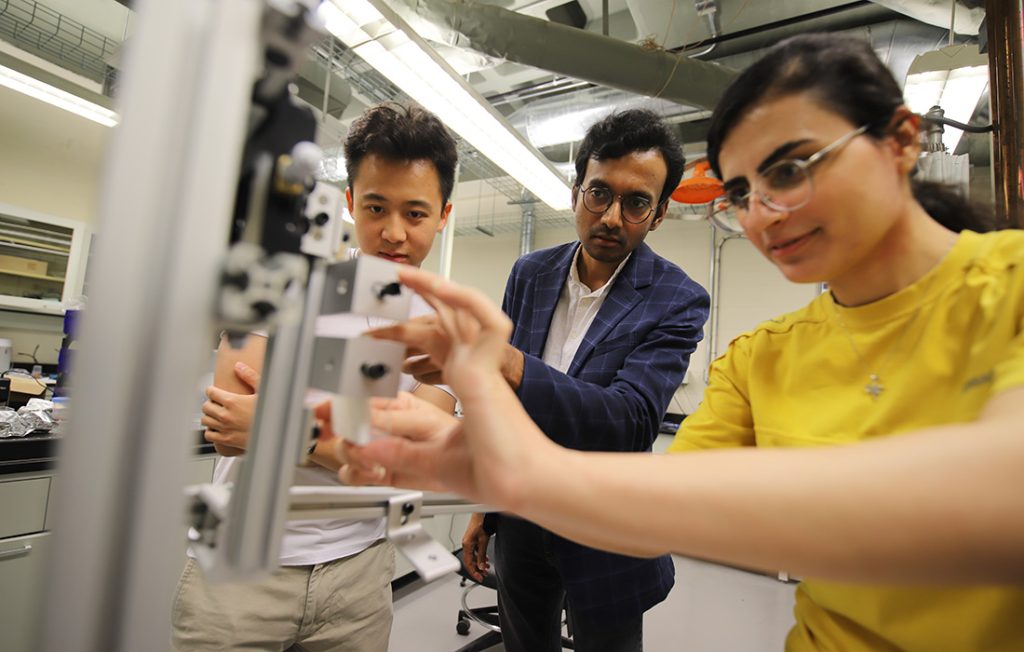
Mechanical and Aerospace Engineering Professor Anupam Pandey has received a National Science Foundation (NSF) grant to establish new strategies for controlling adhesion in ultra-soft and stretchable materials. His project will study how different types of materials stick together by examining thin materials that are partly attached to soft surfaces.
Small air pockets, or blisters, often form when surfaces don’t stick together properly, as seen in smartphone screen protectors or laminated materials. When these blisters are peeled away, one region may detach while another reattaches by itself in a unique transition described as peeling-to-rolling. This process causes noticeable changes in how strongly the surfaces stick together and involves complex interactions that existing methods can’t explain.
Pandey’s project will use analytical models and numerical simulations to understand how the peel-to-roll changes the way objects detach and causes sudden changes in the force needed to pull them apart. Additionally, the research will explore how the shape and arrangement of the air pockets can be engineered to actively control adhesion at the interface.
The findings aim to improve our understanding of how soft materials stick together in tight spaces and help design better soft interfaces for use in medical adhesives, flexible electronics, and soft robotics. To share this work, Pandey and his research team will host activities like a hands-on “Sticky Tapes” exhibit for kids, a summer workshop for high school students, and opportunities for undergraduates to get involved with research.
“This award gives us an exciting opportunity to uncover the mechanics of adhesion of blistered films on soft and stretchable materials,” says Pandey. “I’m eager to see how these insights will inspire both new science and practical applications.”
Using Candles to Make Super-Slippery Surfaces
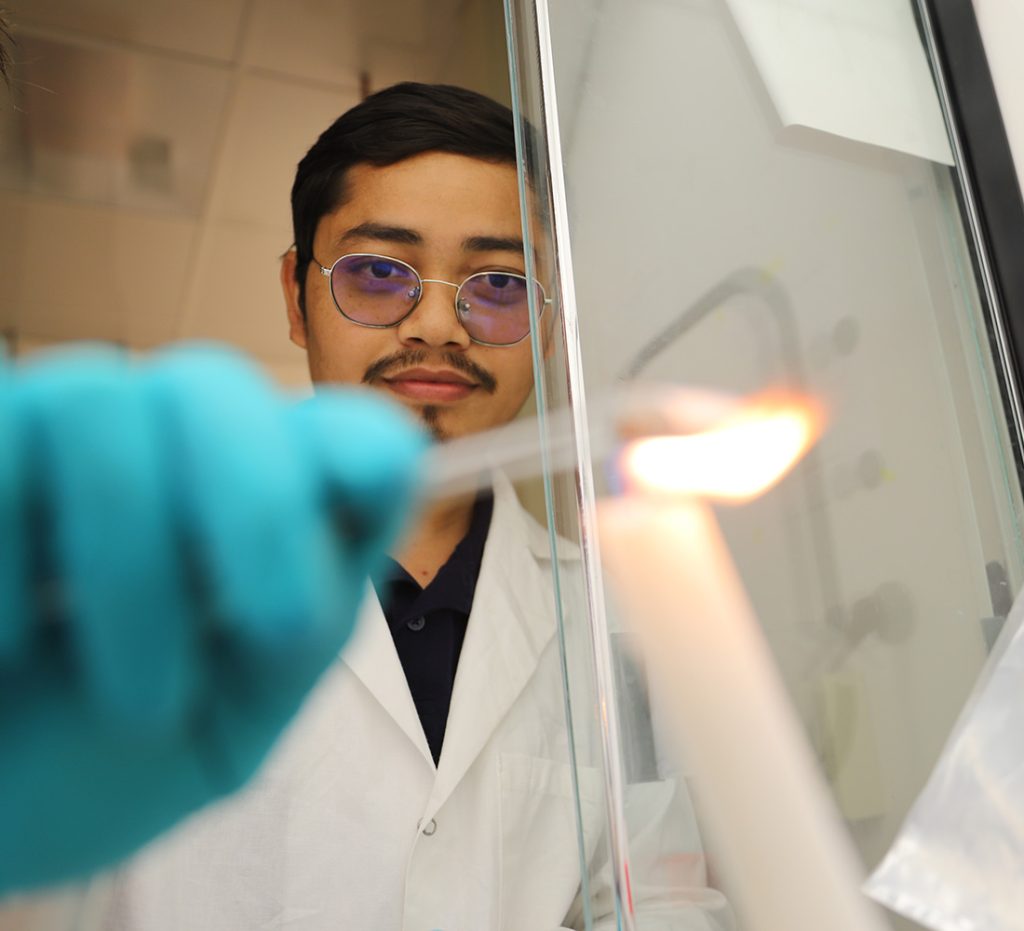
Imagine you are standing on a slippery surface and the slightest imbalance makes you stumble. At Syracuse University, researchers have developed such a surface, not for you (phew!), but for water droplets. Such a super-slippery surface for water, called a superhydrophobic surface, makes water roll-off the surface even if you tilt the surface by just two degrees. Such surfaces can be used for self-cleaning windows, safer medical tools, waterproof clothing, protection of electronics, and even to help ships and planes move faster.
Syracuse University researchers have taken soot coming off a wax candle flame and transformed it into a remarkably durable coating that makes surfaces practically impossible for water to stick to. This invention doesn’t stop at water. It also repels sticky substances like honey and chocolate syrup and even cleans itself from dirt and dust. Unlike other artificially developed water-repelling superhydrophobic coatings, which fail under heat and prolonged exposure to water, the design from Syracuse University proved astonishingly robust. It survived high-speed water jets, chemical baths, saltwater, scorching temperatures up to 650 °F and even a full month submerged underwater, emerging dry and intact.
“The magic comes from a clever combination of candle soot with oil-infused porous silica structure. The porous structure holds the oil which in-turn holds the soot particles making the surface superhydrophobic.” said doctoral student Maheswar Chaudhary, who worked on the project alongside fellow doctoral student Ashok Thapa under the guidance of Mechanical and Aerospace Engineering Professor Shalabh C. Maroo in the College of Engineering and Computer Science. “We have shown this approach to work on both flat and curved surfaces, making it versatile for real-world applications. This isn’t just about repelling water, it’s about creating an easy-to-fabricate coating that truly survives real-world conditions.”
Maroo sees the discovery as a reminder that innovation doesn’t always start with exotic ingredients. “Even something as ordinary as a wax candle can inspire groundbreaking ideas,” he said. “We’ve turned candle soot into science, blending simple materials with simple nanoscale engineering to open up exciting possibilities for technology and sustainability.”
The research was recently published, with open (free) access, in Surfaces and Interfaces.

Tianyi Zhang
Degrees:
- Ph.D., The Pennsylvania State University
- B.S., Tsinghua University
Research Interests:
- Two-dimensional (2D) materials
- Thin-film deposition and engineering
- Surface and interface characterization
- Nanoscale electronics and photonics
My research focuses on two-dimensional (2D) materials, a class of atomically thin materials with unique electronic and optical properties. By advancing their development, I aim to help shape the future of information and communication technologies beyond the limits of conventional materials.
In particular, I develop scalable methods to synthesize high-quality 2D electronic and optical materials, and to engineer their properties at the atomic level. Using advanced, multiscale characterization tools, I work on investigating the relationships of structure, property, and performance of 2D materials. These efforts open pathways to applications in nanoelectronics, quantum information, sensing, and integrated photonics.
Selected Publications:
- Zhang, T.; Krayev, A.; Yang, T. H.; Mao, N.; Hoang, L.; et al. Synthesis-Related Nanoscale Defects in Mo-based Janus Monolayers Revealed by cross-correlated AFM and TERS imaging. Small 2025, 2504742.
- Liu, H.*; Zhang, T.*; Wu, P.; Lee, H. W.; Liu, Z.; et al. Boosting Monolayer Growth of Transition Metal Dichalcogenides by Hydrogen-Free Ramping during Chemical Vapor Deposition. Nano Letters2024, 24, 8277-8286.
- Zhang, T.; Wang, J.; Wu, P.; Lu, A. Y.; Kong, J., Vapour-Phase Deposition of Two-Dimensional Layered Chalcogenides. Nature Reviews Materials 2023, 8, 799–821.
- Zhang, T.*; Liu, M.*; Fujisawa, K.; Lucking, M.; Beach, K.; et al. Spatial Control of Substitutional Dopants in Hexagonal Monolayer WS2: The Effect of Edge Termination. Small 2023, 2205800.
- Zhang, T.*; Voshell, A.*; Zhou, D.*; Ward, Z. D.; Yu, Z.; et al. Effects of Post-Transfer Annealing and Substrate Interactions on the Photoluminescence of 2D/3D Monolayer WS2/Ge Heterostructures. Nanoscale 2023, 15, 12348-12357.
- Zhang, T.; Fujisawa, K.; Zhang, F.; Liu, M.; Lucking, M. C.; et al. Universal In Situ Substitutional Doping of Transition Metal Dichalcogenides by Liquid-Phase Precursor-Assisted Synthesis. ACS Nano 2020, 14, 4326-4335.
Mechanical and Aerospace Engineering Faculty Spotlight: Changmin Shi
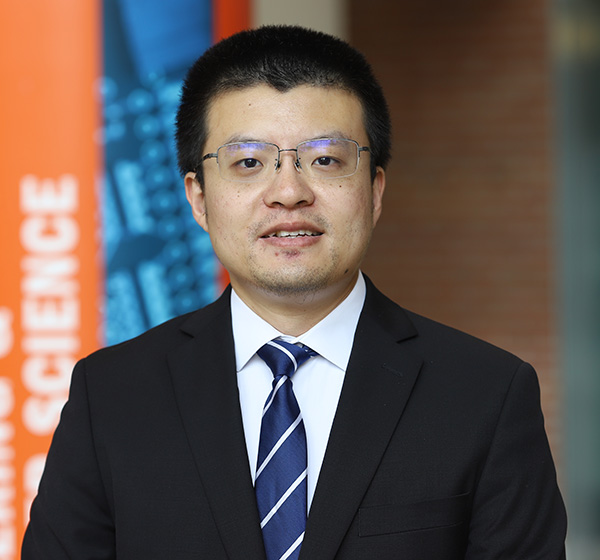
The College of Engineering and Computer Science (ECS) welcomes Changmin Shi to the Department of Mechanical and Aerospace Engineering (MAE). Shi joins ECS in the Fall 2025 semester as an Assistant Professor.
Shi earned his Ph.D. in Materials Science and Engineering from the University of Maryland, College Park. Prior to his faculty appointment at Syracuse University, he spent two years in the School of Engineering at Brown University, where he completed postdoctoral research in energy materials mechanics, thermal energy management, and artificial intelligence.
“Changmin brings a unique expertise to ECS, including both fundamental material sciences and engineering applications,” says Professor Jianshun “Jensen” Zhang, MAE Interim Department Chair and Executive Director of Syracuse Center of Excellence in Environmental and Energy Systems (SyracuseCoE). “His cutting-edge research includes novel electrochemical material systems for batteries and optically tunable materials for thermal energy regulations. I am excited to welcome him to MAE and SyracuseCoE, and look forward to his many significant contributions.”
Shi has worked on multiple groundbreaking innovations in battery and thermal management technologies, including the development of high-energy-density battery designs, novel strategies to suppress lithium dendrite growth and prevent cell failure, sustainable electricity-free cooling systems for buildings, and passive water harvesting and desalination solutions.
Recently, he was selected to serve as a lead symposium organizer for the 250th Meeting of the Electrochemical Society, the leading professional association focused on electrochemistry solid-state science and related technologies. Titled “AI-Driven Battery Materials Design and Manufacturing,” his symposium session will focus on technologies like autonomous manufacturing, predictive modeling of electrochemical properties, and other AI-assisted tools that can help accelerate battery commercialization. The conference will take place in Calgary, Canada in October 2026.
Shi is a Principal Editor of the Journal of Materials Research and a member of Sigma Xi, The Scientific Research Honor Society. He has published extensively on next-generation energy storage batteries and battery technology. In the Spring 2026 semester, Shi will teach a graduate-level course on fundamentals and properties of materials.
Dr. Shi is currently recruiting postdoctoral researchers, graduate, and undergraduate students to his research group. For more information and instructions on how to apply, please visit the Openings page on the Shi Research Group website.
Christian Aponte-Rivera
Institute affiliation – BioInspired Institute
Areas of Expertise:
- Soft materials
- Polymer physics
- Colloidal physics
- Rheology
My research expertise utilizes theory, simulations and experiments to develop a microscopic understanding of complex soft materials. Our goal is to use this knowledge to develop materials with novel mechanical properties, understand disease pathology, and develop materials for energy applications.
Honors and Awards:
- Featured in Nanoscale’s 2025 Emerging Investigators series
- Bouchet Graduate Honor Society, Spring 2018
- The Ephrahim Garcia Graduate Student Excellence in Mentoring Award, Cornell University (Fall 2017)
- NSF Graduate Research Fellowship, Spring 2013
Selected Publications:
· Aponte-Rivera, C.*, Wijesekera, A., Ge, T.* (2025). Nanoparticle Induced Hydrodynamic Flows in Unentangled Polymer Melts. DOI: 10.1021/acs.macromol.5c00743
· Aponte-Rivera, C.* (2025). Start-up flow of nanoscale particles and their periodic arrays: insights from fundamental solutions of the unsteady Stokes equations. Nanoscale 17, 12727–12737 (link) (Featured in the Nanoscale 2025 Emerging Investigator series)
Ethan Arnault
Institute Affiliation: Institute for Quantum & Information Sciences
Areas of Expertise:
- Superconducting devices
- Quantum technology
- Quantum states of matter
- Quantum sensing
My work leverages properties presented by newly emerging quantum and topological materials to design, fabricate and measure devices that provide advantages over typical approaches. This work spans from understanding fundamental physical properties of materials to deploying devices in real-world settings.
Honors and Awards:
Army Education Outreach Postdoctoral Fellowship (2024-2025)
J. Horst Meyer Endowment Fellowship (2020)
Graduate Program in Nanoscience Fellowship (2017)
John Chambers Fellow (2016-2017)
Selected Publications:
E.G. Arnault*, J. Chiles*, C.C. Chen, T.F.Q. Larson, L. Zhao, K. Watanabe, T. Taniguchi, F. Amet, G. Finkelstein, “Multiplet supercurrents in a Josephson circuit”, Phys. Rev. Lett., 134, 067001 (2025)
E.G. Arnault*, B. Huang*, W. Jung*, C. Fried, B.J. Russell, K. Watanabe, T. Taniguchi, E.A. Henriksen, D. Englund, G.H. Lee, K.C. Fong, “Graphene calorimetric single-photon detector” arXiv 2410:22433 (2024)
E.G. Arnault*, A.H. Al-Tawhid*, S. Salmani-Rezaie, D.A. Muller, D.P. Kumah, M.S. Bahramy, G. Finkelstein, K. Ahadi, “Anisotropic Superconductivity at KTaO3 (111) Interfaces” Science Advances, 9, 7 (2023)
E.G. Arnault, S. Idris, A. McConnell, L. Zhao, T.F.Q. Larson, K. Watanabe, T. Taniguchi, G. Finkelstein, F. Amet “Dynamical Stabilization of Multiplet Supercurrents in Multi-Terminal Josephson Junctions”, Nano Letters, 22, 17 (2022)
E.G. Arnault, T.F.Q. Larson, A. Seredinski, L. Zhao, S. Idris, A. McConnell, K. Watanabe. T. Taniguchi, I.V. Borzenets, F. Amet, G. Finkelstein, “The multi-terminal Inverse AC Josephson effect”, Nano Letters, 21, 22 (2021)
L. Zhao, E.G. Arnault, A. Bondarev, A. Seredinski, T. Larson, A.W. Draelos, H. Li, K. Watanabe, T. Taniguchi, F. Amet, H.U. Baranger, G. Finkelstein, “Interference of chiral Andreev edge states”, Nature Physics, 16 (2020)
Changmin Shi
Center/ Institute Affiliations:
Syracuse Center of Excellence in Environmental and Energy Systems
BioInspired Institute
Degrees and Training:
Postdoc., Brown University, 2025
Ph.D., University of Maryland, College Park, 2023
M.S., Columbia University, 2019
B.E., University of Science and Technology Beijing, 2017
Areas of Expertise:
- Battery Materials and Manufacturing
- Passive Thermal Management Materials and Manufacturing
- AI-Driven Manufacturing and Prediction
- Micro/Nano Fabrication
- Recycling
Dr. Shi’s group research is at the interface of materials, advanced manufacturing, and AI-driven methodology to push the frontiers of energy storage batteries and passive thermal-management technologies. The group designs novel materials as well as new recycling and manufacturing approaches to advance next-generation batteries. In parallel, the group designs novel passive materials and materials architectures that enable efficient temperature regulation and water harvesting. By combining fundamental science and applied engineering, the group advances solutions to address grand challenges in energy and environment to promote a circular economy.
Selected Honors and Awards:
Nominated Sigma Xi Full Member, The Scientific Research Honor Society, 2025
Inventor of the Year, 2024
All America Chinese Youth Federation Top Under 30, 2024
Nano Research Energy Young Star Researcher Gold Award, 2023
Chinese Government Award for Outstanding Self-Financed Students Abroad, 2023
Future Faculty Program Fellow, 2022
Outstanding Graduate Assistance Award, 2020
Publications:
Professor Shi’s full publication list is available here.
Exploring the Toughness of Bamboo Skin Through Artificial Intelligence
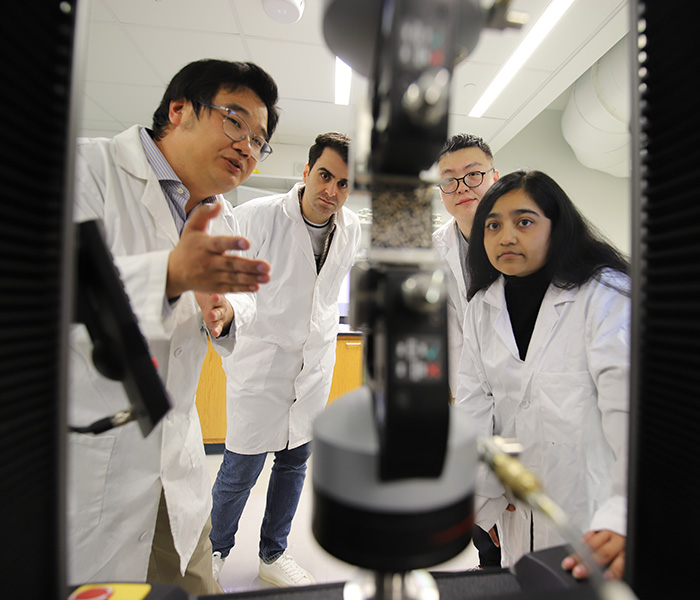
Bamboo is a fast-growing and renewable plant that has important environmental benefits. It grows in many different climates, captures carbon and its root system improves soil health while preventing soil erosion. Bamboo’s natural strength and flexibility have also made it a great alternative to timber and metals for buildings, scaffolding, and many other manufacturing uses.
Studies have shown that bamboo’s outer layer is actually stronger than its inner layers. Known as the epidermis, bamboo’s outer layer is smooth and dense, containing cellulose fiber and silica particles, which contribute to the plant’s functionality and durability. Silica particles in particular may strengthen and help plants like bamboo withstand environmental stresses.
For decades, researchers have been attempting to understand how the low amount of silica particles helps strengthen the outer layer of bamboo and prevent the inner fibers from splitting. To explore this concept, Zhao Qin, assistant professor in civil and environmental engineering, combined theoretical analysis, experimental imaging, generative artificial intelligence (AI) and 3D printing to study how the arrangement of silica particles affects bamboo.
“There are individual particles embedded in the matrix material of bamboo skin,” says Qin. “We realized in the microscopic images of bamboo skin, we see when there are cracks. These cracks will be captured by the silica particles because they are harder and stiffer than the matrix. So, the crack will not propagate straight through the bamboo, but instead, it gives you the zig-zag pathway to dissipate more energy.”
When studying the structure of bamboo skin, Qin found that it’s a composite material, meaning bamboo skin is made from two or more materials with different properties. This material includes soft cellulose fibers and rigid silica particles that are arranged differently in various directions. This arrangement makes the bamboo skin tougher and more durable.
“The silica particles are very ordered in the direction that is perpendicular to the bamboo fiber bundles, with dense areas located where the bundles meet,” says Qin. “Since fiber splitting is the main way bamboo fails under different stresses, such as buckling, bending, and twisting, the silica particles at the fiber junctions help increase the material’s toughness and prevent cracks from spreading. However, their distribution along the fiber is highly disordered.”
To understand how this arrangement affects the toughness of bamboo skin, Qin input his findings into generative AI and created a model based on the structure of bamboo skin. The AI model not only looks similar to actual bamboo skin but also breaks and withstands force in the same way. This research helps us understand the mechanics of bamboo skin better, discover ways to create materials similar to bamboo, or improve the strength of bamboo materials for sustainable development.
“Understanding how the bamboo epidermis works at the microscopic level can help us connect the beginning of mechanical cracks in bamboo with larger issues like buckling and splitting when under extreme pressure,” says Qin. “This understanding is essential for making bamboo products more durable. Additionally, insights gained from the bamboo epidermis can guide the design of composites by defining particle distribution in fiber-reinforced composites, which is important for sustainable construction and manufacturing techniques.”
Kun-Hao Yu
Institute Affiliation: BioInspired Institute
Areas of Expertise:
- Solid Mechanics
- Polymers
- Engineered Living Materials
- Sustainable Infrastructure Materials
- Advanced Manufacturing and 3D Printing
Dr. Yu’s research focuses on the development of sustainable engineered living materials, integrating living cells with synthetic materials to create functional materials with properties such as self-healing, self-growing, and dynamic environmental responsiveness. His research sits at the intersection of Solid Mechanics, Materials Science, Biology, and Advanced Manufacturing, with a focus on designing next-generation materials for infrastructure applications. His work aims to tackle critical global challenges in civil and environmental engineering, such as reducing greenhouse gas emissions, improving clean water access, advancing renewable energy solutions, and enhancing the resilience of structural materials. Through innovative material design, advanced manufacturing techniques (e.g., 3D printing), and fundamental mechanics studies, Dr. Yu seeks to develop materials that mimic biological functions while enabling greater control and manipulation of engineered living materials, ultimately contributing to a more sustainable built environment.
Honors and Awards:
- SES Future Faculty Symposium (FFS) travel award
- NAMRC/MSEC NSF Student Support Award
- EMI-MIMB student paper competition Award
- USC CEE Outstanding Research Assistant Award
Selected Publications:
Ketian Li, Kunhao Yu, Yanchu Zhang, Haixu Du, Constantinos Sioutas, Qiming Wang, Unveiling the mechanism secret of abrasion emissions of particulate matter and microplastics, Scientific Reports, 14, no. 1 : 23710, 2024.
So Hee Nah, Yunchan Lee, Kun‐Hao Yu, Yinding Chi, Hyemin Lee, Baohong Chen, Mohit Patel, Kunyu Wang, Shu Yang, Moisture Absorbing and Water Self-Releasing from Hybrid Hydrogel Desiccants, Advanced Functional Materials, 2313881, 2023
Kunhao Yu, Zhangzhengrong Feng, Haixu Du, Kyung Hoon Lee, Ketian Li, Yanchu Zhang, Sami F. Masri, Qiming Wang, Constructive adaptation of 3D-printable polymers in response to typically destructive aquatic environments, PNAS Nexus, 2022, Vol. 1, No. 3.
Kunhao Yu, Zhangzhengrong Feng, Haixu Du, Qiming Wang, Mechanics of Photosynthesis Assisted Polymer Strengthening, Journal of the Mechanics and Physics of Solids, 151, 104382, 2021.
Kunhao Yu, Zhangzhengrong Feng, Haixu Du, An Xin, Kyung Hoon Lee, Ketian Li, Yipin Su, Qiming Wang, Nicholas X Fang, Chiara Daraio, Photosynthesis Assisted Remodeling of Three-Dimensional Printed Structures, Proceedings of the National Academy of Sciences, 118 (3), 2021.
Kunhao Yu, Haixu Du, An Xin, Kyung Hoon Lee, Zhangzhengrong Feng, Sami F. Masri, Yong Chen, Guoliang Huang, Qiming Wang, Healable, Memorizable, and Transformable Lattice Structures Made of Stiff Polymers, NPG Asia Materials, 12, 26, 2020.
An Xin, Kunhao Yu, Runrun Zhang, Bingyuan Ruan, Allyson L. McGaughey, Zhangzhengrong Feng, Kyung Hoon Lee, Yong Chen, Amy E. Childress, Qiming Wang, Bone-Inspired Healing of 3D-Printed Porous Ceramics, Materials Horizons, 2020.
Kunhao Yu, An Xin, Zhangzhengrong Feng, Kyung Hoon Lee, Qiming Wang, Mechanics of Self-Healing Thermoplastic Elastomers, Journal of the Mechanics and Physics of Solids, 137, 103831, 2020.
Kunhao Yu, An Xin, Haixu Du, Ying Li, Qiming Wang, Additive Manufacturing of Self-Healing Elastomers, NPG Asia Materials, 11, 7, 2019.
Kunhao Yu, An Xin, Qiming Wang, Mechanics of Light-Activated Self-Healing Polymer Networks, Journal of the Mechanics and Physics of Solids, 124, 643-662, 2019.
Kunhao Yu, An Xin, Qiming Wang, Mechanics of self-healing polymer networks crosslinked by dynamic bonds, Journal of the Mechanics and Physics of Solids, 121, 409-431, 2018.
Kunhao Yu, Di Wang, Qiming Wang, Tough and Self-Healable Nanocomposite Hydrogels for Repeatable Water Treatment, Polymers, 10, 880, 2018.
Kunhao Yu, Nicholas X. Fang, Guoliang Huang, Qiming Wang, Magnetoactive Acoustic Metamaterials, Advanced Materials, 1706348, 2018.
New Electromagnetic Absorber Research from Electrical Engineering and Computer Science Professor Younes Ra’di Published in the Nature Communications Journal

Absorbing layers have been fundamental to advancements in technologies like energy harvesting, stealth systems, and communication networks. These absorbers efficiently capture electromagnetic waves across broad frequency ranges, enabling the development of sustainable, self-powered devices such as remote sensors and internet of things (IoT) systems. In addition to energy applications, these layers are pivotal in stealth technology, where they minimize radar visibility and enhance the performance of aircraft and naval systems. They also play a crucial role in improving communication networks by reducing stray signals and mitigating electromagnetic interference, making them essential in our increasingly interconnected world.
Advancements in these technologies requires modules with greater functionality and broader bandwidths, all within smaller footprints, driving the demand for ultra-thin absorbing layers with significantly higher absorption bandwidths. However, a theoretical upper bound exists on the bandwidth-to-thickness ratio of metal-backed, passive, linear, and time-invariant absorbing layers. Absorbers developed to date, irrespective of their operational frequency range or material thickness, significantly underperform when compared to this upper bound, failing to exploit the full potential that passive, linear, and time-invariant systems can provide.
In a new research paper published in Nature Communications, Electrical Engineering and Computer Science Professor Younes Ra’di and his research team introduced a new concept for designing ultra-thin absorbers that enables absorbing layers with a record-high bandwidth-to-thickness ratio, potentially several times greater than that of absorbers designed using conventional approaches. Absorbers designed based on this concept can achieve a bandwidth-to-thickness ratio arbitrarily close to the ultimate bound. Utilizing this concept, they designed and experimentally verified an absorber yielding a very high bandwidth-to-thickness ratio.
“Our findings have the potential to make significant contributions to various industries, including defense, energy harvesting, and advanced communication systems, by addressing critical challenges in electromagnetic absorption technology,” says Ra’di.
“It’s incredibly rewarding to see our work attracting international recognition, not only from the scientific community but also from key players across various industries. I am immensely proud of my team for their dedication and hard work, which have led to these groundbreaking results. Publishing in a prestigious journal like Nature Communications is a testament to their exceptional efforts and the importance of our research.”
Mechanical and Aerospace Engineering Faculty Spotlight: Lihong Lao
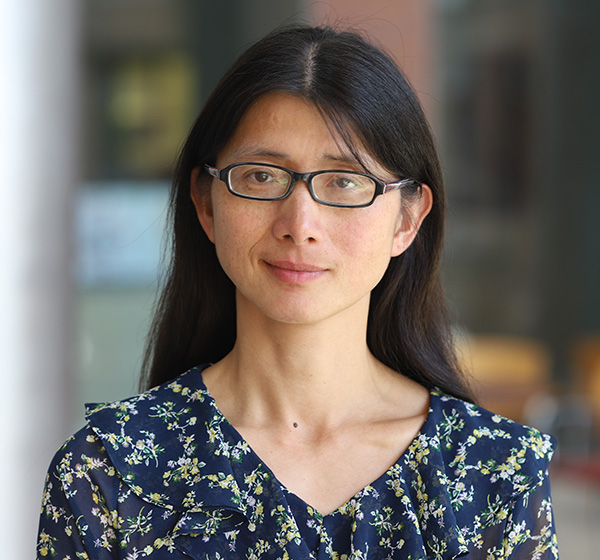
Lihong Lao joined the College of Engineering and Computer Science (ECS) at Syracuse University as an Assistant Professor at the start of the Fall 2024 semester. Lao received her Ph.D. in Fiber and Polymer Science from Cornell University. Lao leads the Environmental Control Materials (ECM) Lab. During the Spring 2025 semester, she will also teach a graduate-level course on polymer materials. Read on for more details about Lao’s research.
Question: Can you give us a brief overview of your research lab?
Professor Lao: My lab focuses on understanding the interaction among the human body, buildings and environment, and improving their performance by developing advanced materials and smart systems. We aim to design smart materials for thermal, moisture and air quality management for the human body and the built environment. Particularly, we use biomimetic approaches inspired by nature for the materials design and engineering based on polymers, fibers, textiles, soft materials, smart materials and advanced manufacturing.
The lab is an interdisciplinary research group within the Department of Mechanical and Aerospace Engineering and is associated with the Syracuse Center of Excellence in Environmental and Energy Systems (SyracuseCoE) and the BioInspired Institute. Our research spans the fields of chemistry, chemical engineering, materials science, mechanical engineering, system engineering and architecture. Our goal is to contribute both scientific fundamentals and practical technologies to serve some global challenges such as human health, environment, energy and sustainability.
Question: Tell us about your current research — are there any projects you’re working on that you’re especially enthusiastic about?
Professor Lao: The research topics in our lab include, but are not limited to:
- Design of smart materials (e.g., stimuli-responsive materials, bio-inspired design, 3D printing)
- Personal thermal and moisture management (e.g., smart textiles, surface wettability, thermal regulation, directional liquid transport)
- Smart building and environment control (e.g., thermal regulation, ventilation control, air quality improvement).
I am particularly excited about developing new materials with self-thermoregulation properties and applying them in smart and green buildings towards energy-saving and sustainability.
Question: What do you like about working at 727 East Washington Street?
Professor Lao: The building is very beautiful and has so many flexible spaces. The indoor thermal condition and air quality are monitored and optimized, making it a comfortable place to work. More importantly, the people are extremely nice, and many faculty members, staff members and students have supported me to quickly adapt to this new environment.
Syracuse University Leads Higher Education Consortium as Part of $40M Award to Advance Central New York’s Semiconductor Manufacturing Capabilities
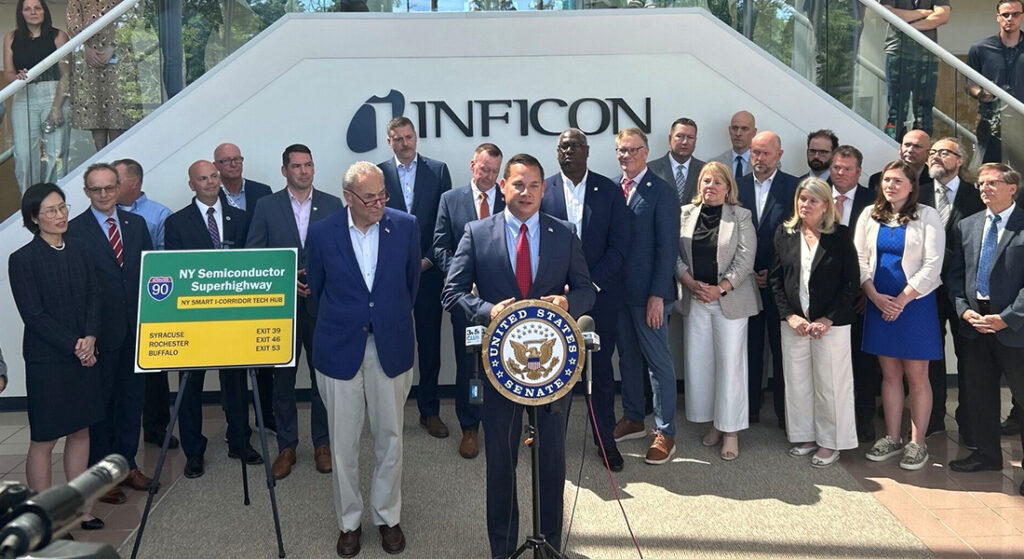
Syracuse University will play a leading role in advancing Central New York’s semiconductor manufacturing capabilities thanks to $40 million in new funds made available to the Buffalo-Rochester-Syracuse region through the U.S. Economic Development Administration’s Regional Technology and Innovation Hub. The new award for the New York Semiconductor Manufacturing and Research Technology Innovation Corridor (NY SMART I-Corridor) was announced yesterday by U.S. Senate Majority Leader Charles Schumer at a press conference in Syracuse hosted by INFICON. J. Michael Haynie, vice chancellor for strategic initiatives and innovation, spoke at the event, and Duncan Brown, vice president for research, represented the University as principal investigator on Syracuse University’s component of the Tech Hub award.
“This is a monumental victory for the Buffalo-Rochester-Syracuse region as the first major Tech Hub award in the nation, bringing a whopping $40 million from my CHIPS and Science Law. With this major investment, the feds are shining a national spotlight, and confirming what I have long known, that America’s semiconductor future runs through the heart of Upstate NY along the I-90 corridor,” said Senator Schumer. “From the fields near Syracuse that will become Micron’s massive mega-fab to the cutting-edge research labs in Rochester and workers learning these manufacturing skills in Buffalo, this award helps connect the region to seize this once-in-a-generation opportunity and establish Upstate NY as the heart of America’s semiconductor industry. I created the Tech Hubs competition with Upstate NY in mind, and pulled out all the stops to win this award—first proposing this program in my Endless Frontier Act, then passing it into law as part of my CHIPS and Science Act, making the case to bring the region together, advocating at the highest levels and delivering the transformational investment to make today possible. It’s never been more clear: the heart of America’s semiconductor industry runs along the I-90 corridor in Upstate NY!”
Syracuse University will lead the NY SMART I-Corridor’s Collaboration and Commercialization Center (C3), which includes Cornell University, Rochester Institute of Technology, University of Rochester and University of Buffalo. C3 will administer millions of dollars in grants to allow small and medium-sized businesses to collaborate with the region’s universities, bring new ideas to market and accelerate growth of the semiconductor industry in the region.
“Syracuse University is proud to lead this higher education collaboration that will help drive innovation and establish the NY SMART I-Corridor as a world leading entrepreneurial incubator for the semiconductor industry,” says Chancellor Kent Syverud. “I am grateful for Senator Schumer’s steadfast advocacy. This substantial new grant builds on major investments the University is making. It will help create critical high-tech infrastructure and facilities, attract top semiconductor manufacturing researchers and faculty to the region, and develop unique experiential learning and internship opportunities for talented students.”
To support the NY SMART I-Corridor, the University is investing $10 million, which is matched by a $10 million investment from Onondaga County, to create a state-of-the-art advanced semiconductor manufacturing facility. The center is part of a more than $100 million investment in strategically transforming STEM and expanding the College of Engineering and Computer Science (ECS) at Syracuse University over the next five years.
“Together with our regional partners, and with the dedicated support of Senator Schumer, Syracuse University has a key role to play in the revitalization of Central New York,” says Haynie. “Today’s announcement is another exciting milestone in the realization of that goal, and we are gratified by the continuing opportunity to foster collaboration and innovation across the Tech Hub.”
As the NY SMART I-Corridor seeks to become the epicenter for American semiconductor commercialization efforts, C3 will integrate the region’s extensive assets into a single “point of entry” for small and medium-sized businesses, according to Brown.
“In our knowledge-driven society, university-led research and development is central to economic development. C3 will allow businesses of all sizes to partner with universities to develop, prototype and test new products,” Brown says. “Through these partnerships, the NY SMART I-Corridor will accelerate the transfer of ideas from lab to market.”
Modeled on New York State’s Centers for Advanced Technology, C3 will drive innovation in the I-Corridor’s semiconductor supply chain by establishing:
- Innovation Asset/Expertise Engagement Network, an inventory of semiconductor relevant facilities and innovation expertise across the I-Corridor, accessible via a central online portal;
- Knowledge/IP Collaboration Architecture, a new IP architecture for the region that incentivizes cross-collaboration between sectors and institutions and strengthens commercialization efforts in the I-Corridor; and
- Formal Community of Practice, which will facilitate collaboration between businesses, researchers, investors and manufacturers in the region and sponsor programming and internships designed to benefit underrepresented communities.
The federal Tech Hub designation spans Syracuse, Rochester and Buffalo and includes Ithaca, Auburn and Batavia. Key academic partners include Monroe Community College in Rochester, which will lead the hub’s workforce development efforts, and University at Buffalo, which will lead the effort to improve the region’s supply chain for semiconductors.
Schumer created the Regional Tech Hubs competition as part of the CHIPS and Science Bill, and said the three-region consortium beat out hundreds of applications and was one of only 31 regions across the U.S. chosen for the Tech Hub designation.
Syracuse University, Onondaga County Make Combined $20M Investment to Launch the Syracuse University Center for Advanced Semiconductor Manufacturing
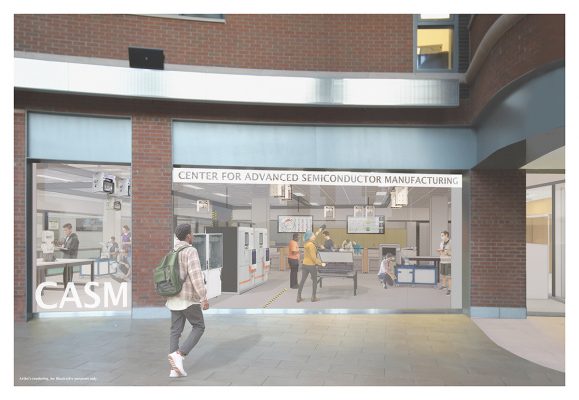
Syracuse University today announced its plans to launch the Syracuse University Center for Advanced Semiconductor Manufacturing, an interdisciplinary center that will bring together expertise in artificial intelligence (AI), cybersecurity, manufacturing processes, optimization and robotics to advance the science of semiconductor manufacturing. The center will be funded by a $10 million investment from the University, as well as a $10 million grant from Onondaga County. The center is part of a more than $100 million investment in strategically transforming STEM and expanding the College of Engineering and Computer Science (ECS) at Syracuse University over the next five years.
Housed in the University’s Center for Science and Technology and situated within ECS, the new center will position the University and Central New York as a global leader in research and education on the intelligent manufacturing of semiconductors.
“Syracuse University and Onondaga County have a longstanding history of collaborating in ways that are mutually beneficial for our students, faculty and staff; the Central New York community and the economic prosperity of our region,” says Chancellor Kent Syverud. “I am grateful for the county’s support. I look forward to the teaching and research that will occur at this new center as well as the meaningful ways that its educational outcomes will contribute to a thriving advanced semiconductor manufacturing industry in Central New York.”
Today’s announcement comes as Micron Technology continues its $100 billion investment in Central New York, which is expected to create 50,000 new jobs in the region, including 9,000 high-paying jobs directly with Micron. Micron will also invest $500 million in community and workforce development, focusing on assisting traditionally underrepresented and disadvantaged populations while training or retraining the region’s workforce.
Onondaga County Executive Ryan McMahon, who was central to attracting Micron to Central New York, says this new facility will play a significant role in helping to drive economic development, cultivate the talent pipeline, attract federal research and development funding and build the semiconductor supply chain in Syracuse.
“As Onondaga County prepares to become the hub for memory technology chip production, we know that we will need our partners in higher education to help develop the necessary workforce critical to ensuring our success,” says McMahon. “With this historic investment by Onondaga County and Syracuse University to launch the Center for Advanced Semiconductor Manufacturing, we are taking a huge step forward in that effort. This new center will serve as a vital workforce pipeline as Micron proceeds with the largest investment in the country at White Pine Business Park. I want to thank Chancellor Syverud and the entire team at Syracuse University for their commitment and partnership in making this important initiative a reality.”
The new Syracuse University Center for Advanced Semiconductor Manufacturing will drive progress in manufacturing processes across the semiconductor supply chain. A state-of-the-art teaching and research facility, it will replicate an autonomous-advanced manufacturing floor enabling research and design that will make Syracuse and the United States globally competitive in semiconductor manufacturing technologies. Students will be trained in the manufacturing technologies of today and create the new ideas that will drive the industry tomorrow. This university’s ongoing partnership with Micron and the county will ensure that Onondaga County can deliver chips through the most high-quality and cost-effective manufacturing processes possible for years to come.
“Central New York is about to undergo a once-in-a-generation transformation and Syracuse University will play a critical role as one of the region’s key higher education partners,” says Vice Chancellor for Strategic Initiatives and Innovation J. Michael Haynie. “We are proud to partner with the county, Micron and other community and business leaders to prepare a workforce in a way that capitalizes on all of the economic opportunities facing our region today.”
The new center is aligned with the University’s academic strategic plan and leverages the investment it has already made in AI, manufacturing, quantum technologies and precision measurement. Over the next five years, the University will hire more than 10 new faculty at various ranks with expertise in manufacturing process engineering and automation, optimization and artificial intelligence, materials science engineering and other related fields.
“Not only will this center support economic and workforce development, it will also generate significant academic opportunities for both our students and our faculty from a teaching, learning and research perspective,” says Vice Chancellor, Provost and Chief Academic Officer Gretchen Ritter. “There is huge demand for trained professionals in and across these fields and Syracuse University will be at the forefront of preparing the next generation of scientists, engineers and leaders in the advanced semiconductor manufacturing space.”
The center’s research will drive the improvements in manufacturing needed to give designers the ability to create tomorrow’s most advanced chips. It will also deliver the skill sets needed by today’s semiconductor industry by educating graduate and undergraduate students in cutting-edge manufacturing and supply-chain technologies.
ECS Dean Cole Smith, who is leading the efforts to expand engineering at Syracuse, says the new center will allow the University to attract and retain diverse and talented student scholars from across the globe who will come to Syracuse to live, learn, study and work. The University will also work closely with the county and the City of Syracuse to recruit students from area high schools, including the new STEAM High School. These efforts directly support the College of Engineering and Computer Science’s plan to grow its undergraduate enrollment by 50% by 2028.
“We want to make advanced manufacturing tangible, exciting and accessible for all students, even if they have not yet seen engineering and computer science as a potential career field,” says Dean Smith. “One of the most exciting aspects of this center is in its dual use for research and education. Prospective students, especially those coming from Central New York, will see amazing opportunities for themselves in the field of semiconductor manufacturing. Instead of just reading about the industry, they will both witness exciting research and interact with an automated, intelligent factory floor when they visit the center.”
Work to transform existing space into the new facility is underway.
An Inside Look at Professor Pankaj Jha’s New Quantum Technology Lab
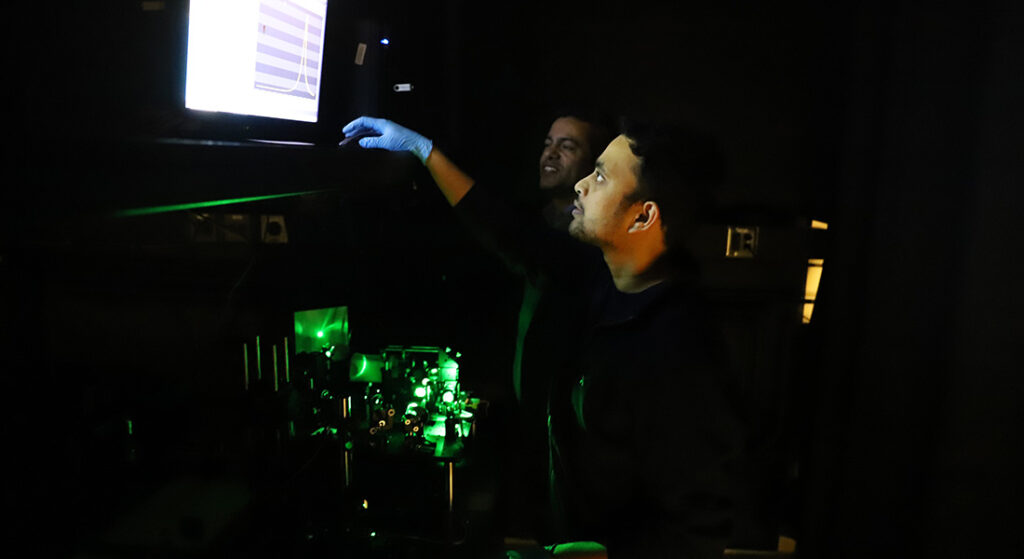
Two-dimensional (2D) materials are the thinnest nanomaterials known to exist. Being only about a single or few layers of atoms thick, these delicate sheets have found many applications in electronic devices, quantum optics, and photovoltaic technology. Pankaj K. Jha, assistant professor in electrical engineering and computer science, is leading a quantum technology laboratory with members Aswini Pattanayak, Jagi Rout G’28, Amir Targholizadeh G’28, Theodore Todorov ’26, and Grisha Nikulin ’27 to understand emerging 2D materials and use their findings to develop transformative devices for applications in quantum information science.
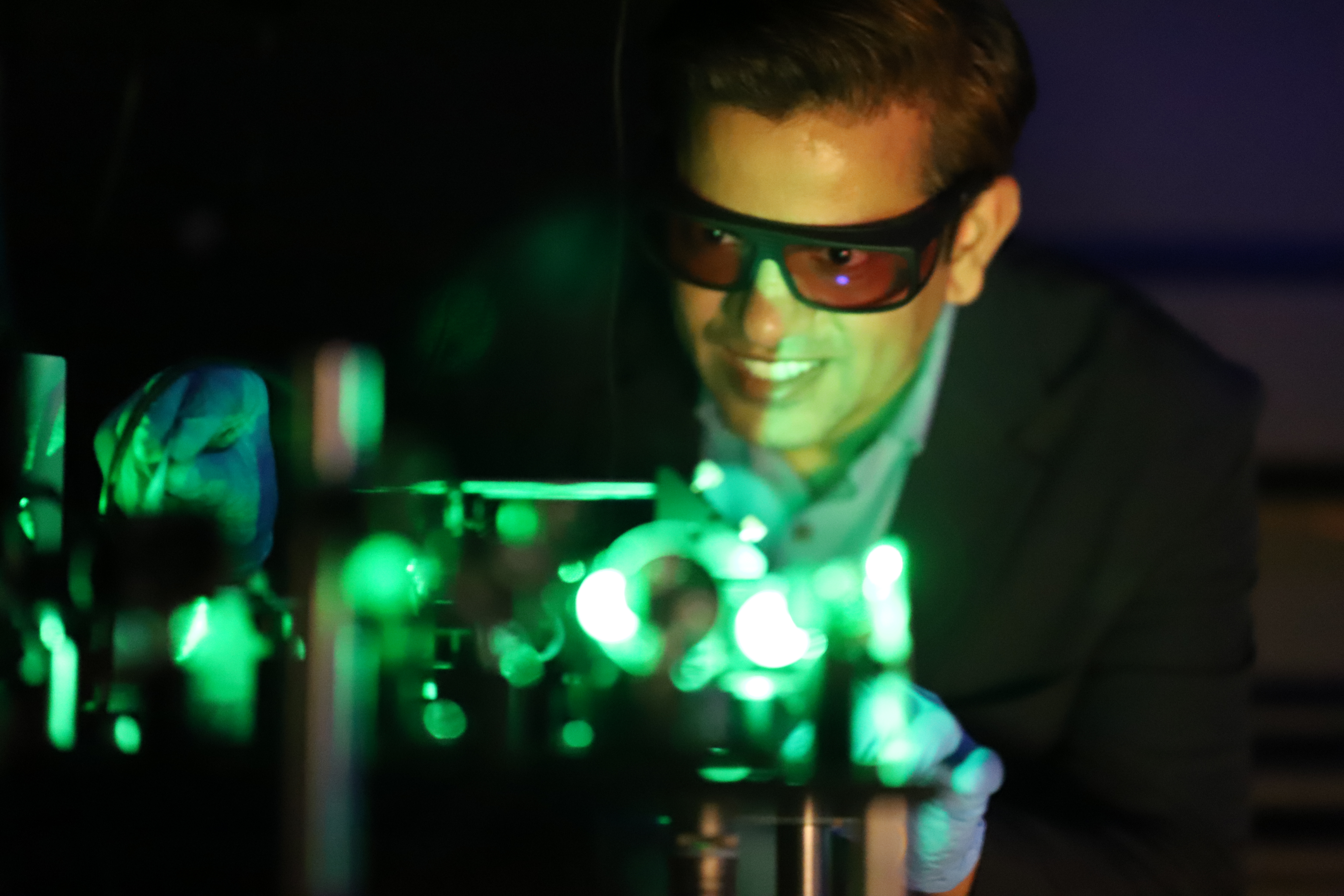
Jha is developing single-photon detectors using iron-based superconductors that could work at higher temperatures. Currently, superconducting photodetectors require low temperatures to operate. Pattanayak, a post-doctoral scholar, is leading this project to understand photodetection in iron-chalcogenide-based superconductors and investigating the interaction between these superconductors with other 2D van der Waals (vdWs) materials, exploring unique quantum phenomena at their interfaces.
“High-temperature single photon detectors will have both scientific and fundamental impact. Any application that requires sensitive photon detectors will benefit from these devices,” Jha says.
Pattanayak is also mentoring Todorov, an undergraduate student, in light interferometry. Interferometers combine light to create an interference pattern that can be measured and analyzed. “Interferometry is the basis of optics because it allows you to analyze the classical and quantum optical properties of light,” Todorov says. “The resulting interference can allow one to understand properties of the laser such as path length, wavelength, and refractive index of the medium it has passed through.”
“In this era of quantum exploration, the investigation of superconductors serves as the cornerstone for unlocking unparalleled frontiers in quantum technologies and devices,” says Pattanayak.
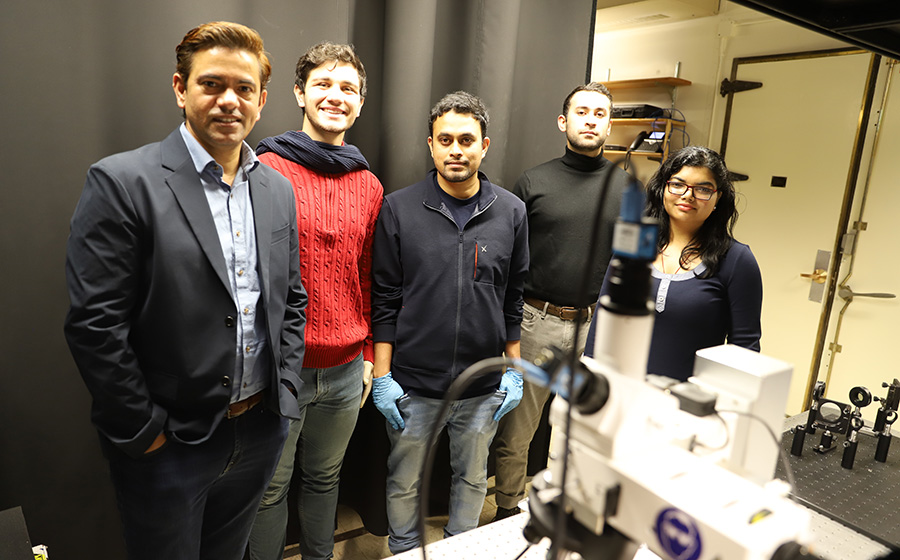
Rout, a graduate student, is exploring heterostructures using nanofabrication techniques. Her research focuses on studying high-temperature superconductivity. In addition to working on single-photon detectors, Rout is developing Josephson junctions, devices made by placing thin, non-superconducting materials between two superconductors, and she’ll be using iron-chalcogenide-based superconductors.
“The interplay among topology, magnetism, and superconductivity makes our material an intriguing platform to investigate the strange yet promising interactions in the subatomic realm,” says Rout.
Rout is also mentoring Todorov and Nikulin in the exfoliation of 2D materials. Nikulin’s interest is Superconducting Qubit Architecture and Quantum Algorithms. “Superconducting-based photon detection also has significant applications towards reducing quantum decoherence in quantum computation systems,” says Nikulin.
Targholizadeh, a graduate student, is developing flat photonic devices based on metasurfaces capable of functioning at extremely low temperatures. He aims to address and solve some of the outstanding challenges that single photon detectors face, such as polarization sensitivity, and near-normal incidence requirements, among other issues.
“Metasurfaces are recently introduced as a new paradigm for nanophotonic devices, and in our laboratory, we are working on conceiving, designing, fabricating, and testing these metasurface-based devices,” Targholizadeh says.
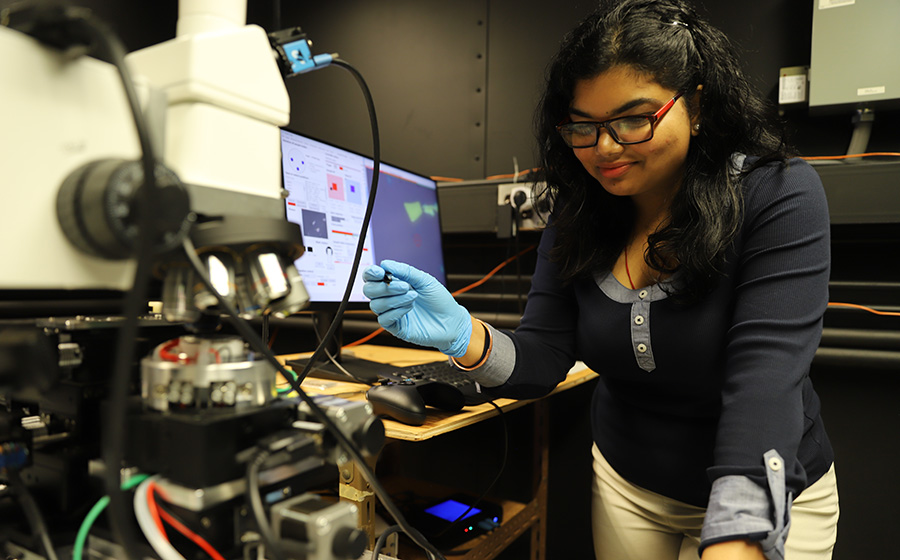
In addition to research, Jha started a quantum information science and engineering seminar (QISE) at Syracuse University with support from an internal FCAR Grant. With speakers from academia, industry, and national labs, seminars are open to all and cover experimental and theoretical topics in QISE and adjacent research.
“The response to the QISE Seminar Series has been outstanding, with 60-70 % student audience participation,” Jha says. “I see a bright future for quantum science at the University.”
Click here to learn more about the QISE Seminar
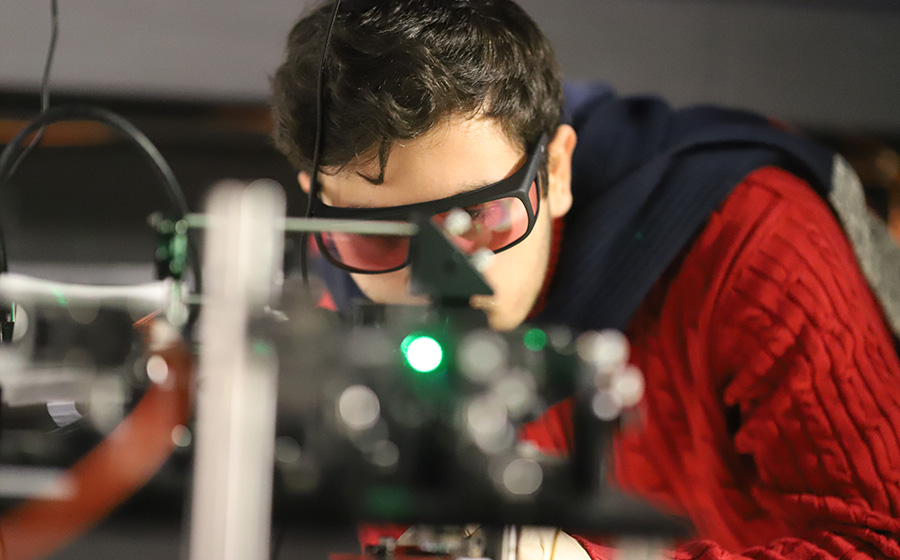
Electrical Engineering and Computer Science Professor Younes Radi Appointed as Senior Member and Associate Editor of IEEE
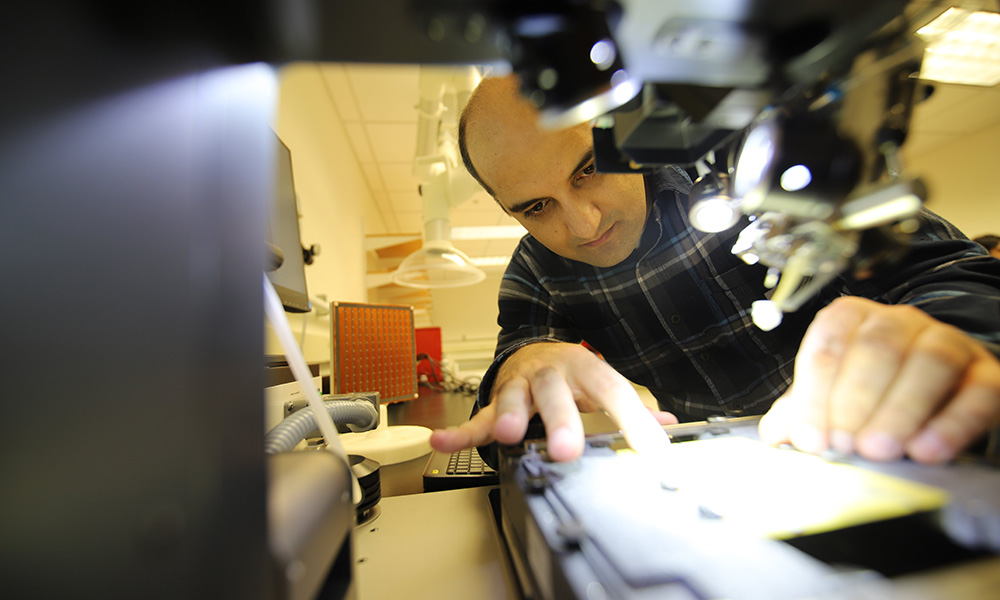
Younes Radi, assistant professor in electrical engineering and computer science, has been recognized as a Senior Member of the Institute of Electrical and Electronics Engineers (IEEE) for his contributions to research in applied electromagnetics and microwave engineering. He has also been chosen as an Associate Editor for the IEEE Transactions on Antennas and Propagation.
The IEEE is a global organization devoted to advancing technology for humanity’s benefit. Senior Membership is awarded to members who have made a significant impact within their fields. Only 10% of the IEEE’s more than 400,000 members hold this grade, which requires extensive experience, professional maturity, and documented achievements of significance.
Radi’s research focuses on the physics of fields and waves, with emphasis on tailoring electromagnetic wave-matter interaction. He has made significant scientific contributions on a broad range of topics in theoretical and applied electromagnetics, optics, and photonics, including artificial electronic and photonic materials, RF/microwave circuits, antennas, and propagation. His papers have been published in several high-impact journals including Nature Physics, Nature Communications, National Science Foundation, and IEEE family journals.
In addition to his Senior Membership and becoming an Associate Editor at IEEE Transactions on Antennas and Propagation, Radi has also been chosen by the University as one of the two faculty to compete in the 2024 Moore Inventor Fellows Program. These recent achievements reflect Radi’s focused efforts to re-establish Syracuse University as a renowned center of electromagnetics and microwave engineering research.
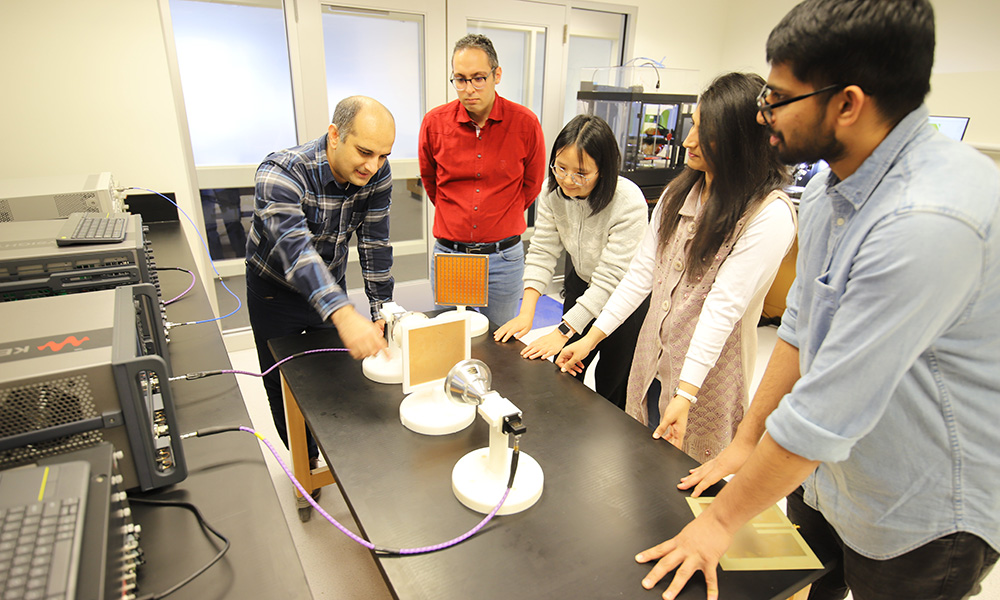
“Syracuse University has a rich history in applied electromagnetics and microwave engineering and was one of the leading universities in the world in this field,” says Radi. “I’ve been to many places in Europe and the US and have never seen a city like Syracuse where you can find so many high-end companies in applied electromagnetics and microwave engineering. This creates a great platform to bridge the research in my team with the local industry.
“I am extremely grateful to the department, college, and also the office of VPR for their amazing support in establishing a state-of-the-art RF and mm-Wave laboratory, which we have named ‘RadLab.’ This facility will pave the way for new collaborations with local industry and position Syracuse as a highly active hub for advanced research in applied electromagnetics and microwave engineering.”
Biomedical and Chemical Engineering Professor Mary Beth Monroe Receives Young Investigator Award from the Society for Biomaterials
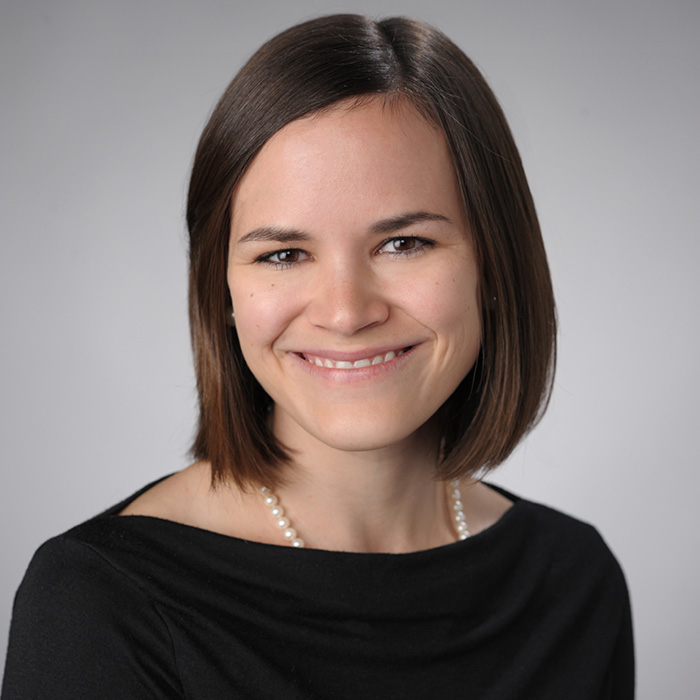
Assistant professor in biomedical and chemical engineering Mary Beth Monroe has received the Young Investigator Award from the Society For Biomaterials. This award recognizes an individual who has demonstrated outstanding achievements in biomaterials research.
The Society For Biomaterials is a group of multidisciplinary professionals from various fields including academia, healthcare, government, and business. They aim to advance biomaterial science and education to improve professional standards for human health while promoting excellence in biomaterial science, engineering, and technology.
Monroe’s research is focused on engineering new biomaterials to address clinical needs in wound healing. Seeking to make significant strides in polymer chemistry to facilitate safer, more efficient medical devices, her biomaterials lab conducts basic and applied research to produce and analyze polymeric biomaterials that enhance healing outcomes.
“Dr. Monroe is off to a fantastic start as a junior faculty member, and she brings tremendous creativity, energy, and enthusiasm to her research lab, teaching, mentorship activities, and service efforts. We expect her to continue to lead in these areas and to excel as a biomaterials scholar as she inspires those around her to lead as well,” says the SFB BioInterfaces Special Interest Group Awards Committee, Ashley Brown, Benjamin Keselowsky, and Christopher Siedlecki.
“I have been engaged with SFB since my first semester of graduate school,” says Monroe. “It is a huge honor to be recognized by this scientific society that has had such a huge impact on my career by providing me with mentors, collaborators, and an outlet for scientific inquiry over the past 10+ years.”
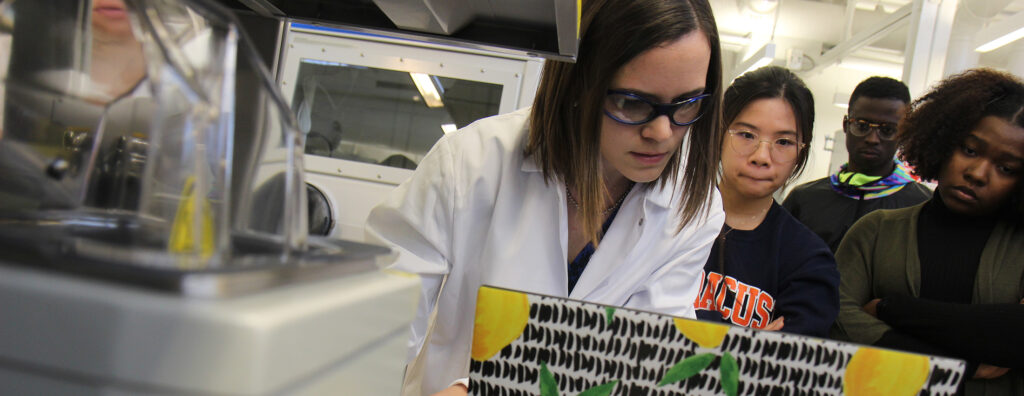
Nature-Inspired Research
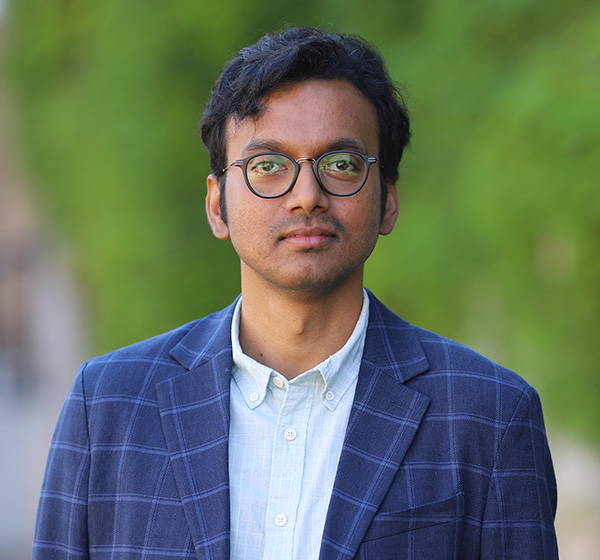
Apple snails are one of the most invasive species on our planet. Consuming several plants that provide food and habitats for various wildlife, and disrupting entire ecosystems, these snails have earned a permanent ban from the United States, only allowed in the country for research. Along with the damage they leave in their slow path of destruction, these shelled creatures also possess an ability that’s unique to their species.
By wiggling its flexible foot underwater, an apple snail can create a flow that brings floating food particles to itself, a process biologists refer to as “pedal foot collection.” Fascinated by the snail’s unique ability, this would inspire the latest research of a mechanical and aerospace engineering professor, Anupam Pandey, whose findings were published in the high-impact science journal Nature Communications.
“One of my research interests is understanding how soft, highly deformable, solid materials interact with adjacent liquid flow,” Pandey says. “Organisms that live underwater exploit this interaction for locomotion and feeding. Apple snails have evolved to leverage their proximity to the water-air interface to transport or pump liquids.”
To understand the process behind pedal foot collection, Pandey designed a robot the size of a centimeter that oscillates rhythmically and mimicked the apple snail’s motion. He then placed the robot underwater in a tank and sprinkled Styrofoam particles on the surface to see if it could collect it, discovering that the robot functioned similarly to a pump.
“We found that our bio-inspired robot was able to drag particles from distances that are five times its size. But more interestingly, we found an optimal speed at which pumping maximizes,” explains Pandey. “This optimal speed seemed to depend on robot geometry as well as the properties of the liquid it’s submerged in. Combining experiments and modeling, we predicted the optimal conditions under which the robot pumps the most liquid.”
In addition to understanding the role speed and liquid play in how the robot collects small objects and pumps liquid, Pandey also tracked the pattern of Styrofoam particle movement through long exposure photography, which he color-coded to make it easier to see how the particles moved.
While the small, oscillating robots have the potential for numerous applications, one notable benefit is as a collection device. Pandey believes that they could help address issues involving the collection of microplastics in oceans, which tend to remain at the water’s surface due to their small size.
Most plastic collection devices create strong disturbances at the water surface and cause microparticles to mix in the water. These microplastics travel to other water bodies, causing more plastic pollution which harms plants and animals and inevitably ends up in our food chain. However, devices like the undulating robot operate near the water’s surface with minimal interference and could potentially provide a solution to this problem.
“What’s great about this research is how interdisciplinary it is. Biologists may be interested in this, and it has several potential applications in engineering liquid flows at small scales, sensing and actuation of floating objects or even microplastics in water bodies,” Pandey says. “It will not only advance understanding of liquid transport near surfaces but lay the groundwork for future research as well.”
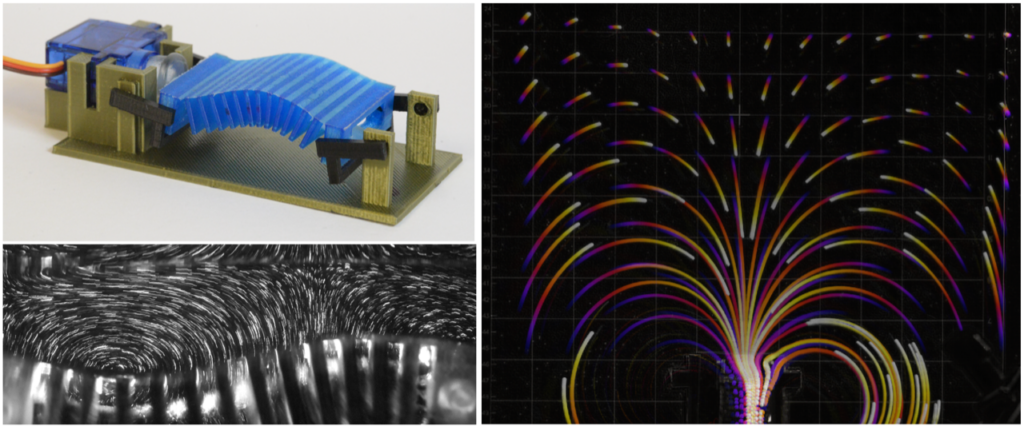
Professor Wanliang Shan Receives NSF CAREER Award for Research on Tunable Adhesion
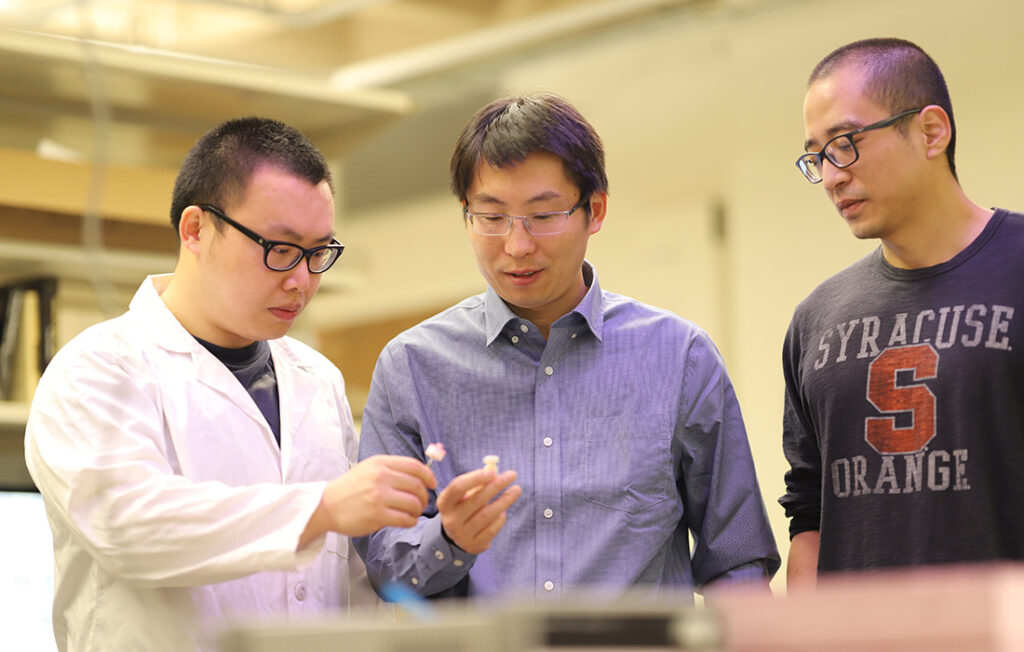
Wanliang Shan, assistant professor of mechanical and aerospace engineering at the College of Electrical Engineering and Computer Science (ECS), has received a National Science Foundation (NSF) CAREER Award to research the mechanics behind highly tunable dry adhesion for manipulating delicate and small objects.
The NSF CAREER Award supports early-career faculty with promising research and the potential to serve as academic role models. This project will significantly advance tunable adhesion for compliant manipulation, which Shan’s team has studied for the past seven years. Focused on the ability to pick up and release objects by adjusting the level of adhesion, his work has been published in high-impact journals such as Advanced Functional Materials and Advanced Materials Interfaces.
Shan’s team previously explored adhesion tuning using smart materials in soft pillars. Heating the smart material component with an electrical current, or power source, activates the device within seconds, resulting in a significant change in the adhesion of the soft pillars. This discovery earned Shan a patent which was issued in the Spring of 2022 and his team is currently working on an NSF Partnership for Innovation grant to explore the potential commercialization of this approach.
Shan’s NSF CAREER project introduces a new method for achieving tunable adhesion. Rather than using heat to activate the device, this method uses low pressure to activate adhesion which allows objects to be gripped and released efficiently at a faster rate. Shan found that a greater amount of adhesion change can be achieved within a fraction of a second compared to his previous method. This innovative approach focuses on a specific type of adhesive structure called soft hollow pillars and a provisional patent has been filed for this new approach.
The CAREER project delves deeper into understanding the mechanics behind highly tunable adhesion observed in soft hollow pillars and investigates the role of mechanical instability, specifically the buckling of thin structures under low pressure, which will give Shan insights into optimizing the design of adhesive devices. By understanding the influence of these factors, the project seeks to further improve the functionality and effectiveness of adhesive devices.
“In certain applications like manufacturing, devices need fast, repetitive movements to perform tasks,” Shan says. “In other applications, however, these devices don’t require the same movements. This is why I believe both approaches to tunable adhesion are important.”
Shan will continue incorporating findings from research into the courses he teaches at Syracuse University. Since 2019, he’s been a faculty member of ECS, where he teaches courses on solid mechanics and soft robotics. He also intends to seek internship opportunities at relevant companies for graduate students who participate in the CAREER project, a strategy he’s used to interact with industrial partners leveraging existing NSF grants. Collaborating with the Museum of Science and Technology in downtown Syracuse, he’s also proposed education and outreach initiatives such as mechanics-enabled soft robotics summer camps. These are intended to educate the general public, especially K-12 students, about his team’s research.
“There’s a significant educational aspect to this CAREER award,” Shan says. “This will be great for students and my lab at Syracuse University. I look forward to incorporating findings from this research into lecture material, both for undergrad and graduate students. The summer camps will help disseminate research outcomes to the general public and foster interest in the next generation of engineers.”
“This project not only has all the fundamentals of mechanics but also carries practical ramifications for compliant manipulation,” Shan added. “Bringing this research to my classroom and the potential impact these findings will have on technology is all very exciting. I appreciate the National Science Foundation for this award for allowing me the opportunity to carry out this exciting project.”
Civil and Environmental Engineering Professor Zhao Qin Recognized as International Association of Advanced Materials Fellow
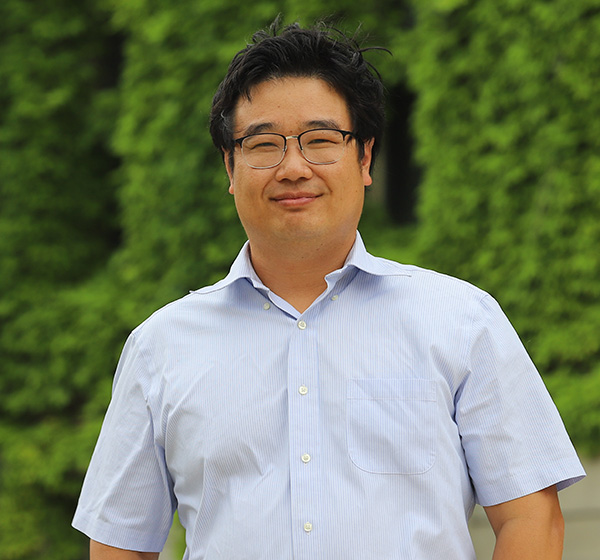
Zhao Qin, assistant professor of civil and environmental engineering in the College of Engineering and Computer Science (ECS), has been selected as an International Association of Advanced Materials (IAAM) Fellow in recognition of his contribution to the Advancement of Materials to Global Excellence. He will deliver an IAAM Fellow Lecture in the Advanced Materials Lecture Series 2023.
Founded in 2010, IAAM has been the leading advocate for advancements in advanced materials science, engineering, and technology. With its focus on social implications, the non-profit scientific organization encourages scientists to consider the broader impact of their work and aims to foster open and informed conversations in science, engineering and technology.
The primary aim of the organization is to optimize the resourcefulness of the world of science to improve the quality of human life by conducting high-quality research. Boasting a roster of over 7,500 scientists and invited speakers from over 100 countries, IAAM’s Advanced Materials Lecture Series hosts talks by renowned scientists, promoting innovation and sustainability for an eco-friendly world.
“I am deeply honored to be named as an IAAM Fellow,” Qin said. “This recognition is a testament to our group’s dedication and hard work on material innovation studies by integrating multi-scale computational modeling and experiments. It is also a reflection of the exceptional support and commitment of my students and colleagues. I would like to express my heartfelt gratitude to my students, whose enthusiasm and eagerness to learn have constantly inspired me to strive for excellence in my teaching and mentorship.
“Their inquisitive minds and unwavering determination have been instrumental in shaping my approach as an educator. Additionally, as a junior faculty member, I am incredibly grateful to my colleagues in my department and school for their invaluable collaboration, guidance, and encouragement throughout this journey. Their expertise and unwavering support have fostered an environment of growth and innovation, enabling me to reach new heights in my research endeavors.”
Engineered Magic: Wooden Seed Carriers Mimic the Behavior of Self-Burying Seeds

Before a seed can grow into a tree, flower or plant, it needs to successfully implant itself in soil – a delicate and complex process. Seeds need to be able to take root and then remain protected from hungry birds and harsh environmental conditions. For the Erodium flower to implant a seed, its stalk forms a tightly wound, seed-carrying body with a long, curved tail at the top. When it begins to unwind, the twisting tail engages with the ground, causing the seed carrier to push itself upright. Further unwinding creates torque to drill down into the ground, burying the seed.
Inspired by Erodium’s magic, Mechanical and Aerospace Engineering Professor Teng Zhang worked with Lining Yao from Carnegie Mellon University (CMU) and a team of collaborators to engineer a biodegradable seed carrier referred to as E-seed. Their seed carrier, fashioned from wood veneer, could enable aerial seeding of difficult-to-access areas, and could be used for a variety of seeds or fertilizers and adapted to many different environments. The carriers also could be used to implant sensors for environmental monitoring. They might also assist in energy harvesting by implanting devices that create current based on temperature fluctuations.
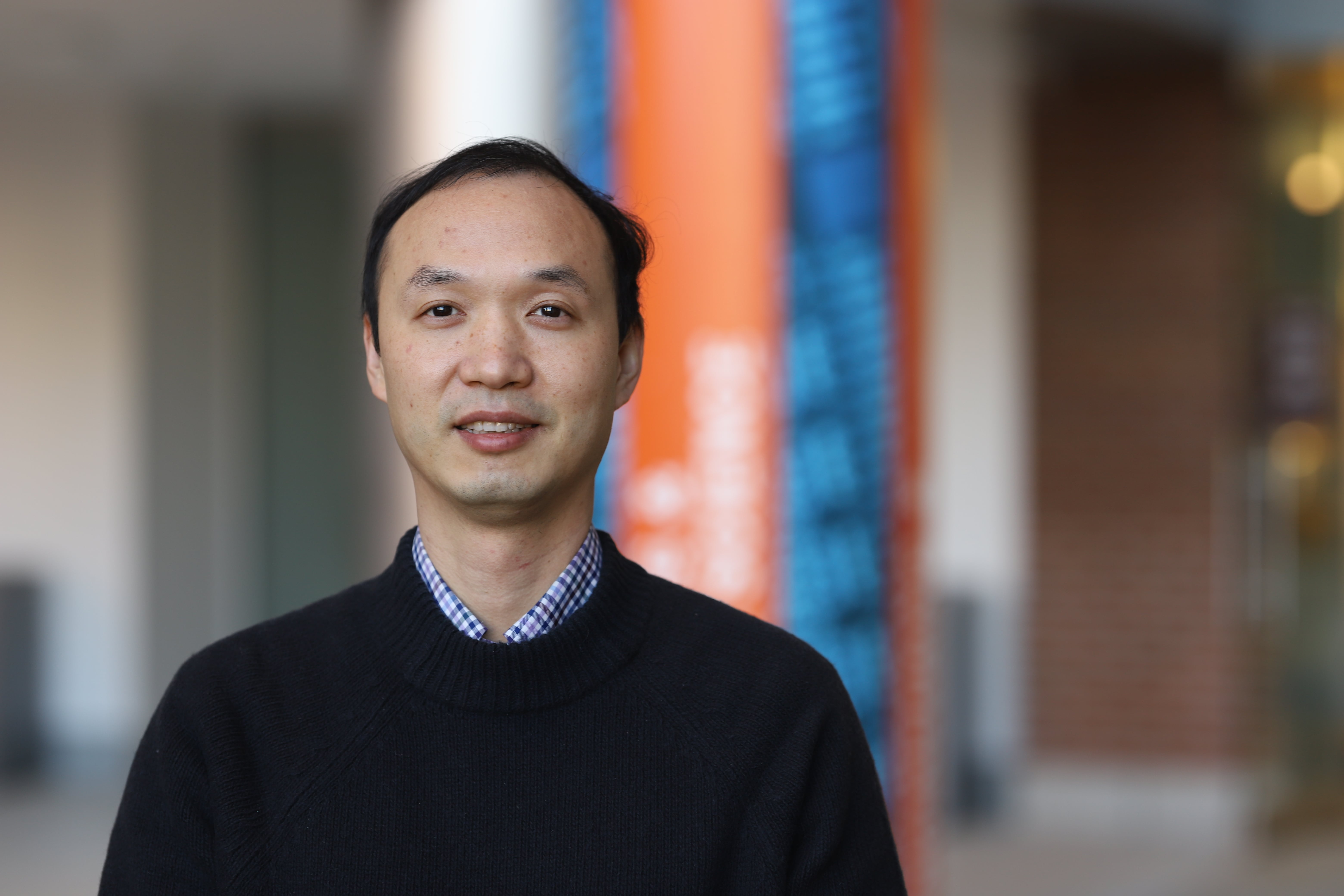
“This is a perfect example demonstrating the beauty and power of bioinspired design. We learn from nature and eventually achieve superior performance by leveraging the freedom of engineering design,” said Zhang, who also serves as an executive committee member of the Bioinspired Institute.
The team’s research appeared in the February issue of Nature.
The project is led by Lining Yao, director of the Morphing Matter Lab in the School of Computer Science’s Human-Computer Interaction Institute at CMU. Zhang developed models and performed simulations to explain the working mechanism of the wood actuators and the benefits of E-seed design. The key authors of the paper also include Danli Luo, a former research assistant at the Morphing Matter Lab, Shu Yang, a materials scientist from the University of Pennsylvania, Guanyun Wang, a former postdoctoral researcher in the Morphing Matter Lab and now a faculty member at Zhejiang University, and Aditi Maheshwari and Andreea Danielescu from Accenture Labs.
“Seed burial has been heavily studied for decades in terms of mechanics, physics and materials science, but until now, no one has created an engineering equivalent,” said Yao. “The seed carrier research has been particularly rewarding because of its potential social impact. We get excited about things that could have a beneficial effect on nature.”
“Gaining insight into the mechanics of wood and seed drilling dynamics leads to improved design and optimization,” said Zhang. “I am excited to see, by embracing cross-disciplinary collaborations, mechanics can play a critical role in making our society more sustainable.”
Read more about this collaborative project.
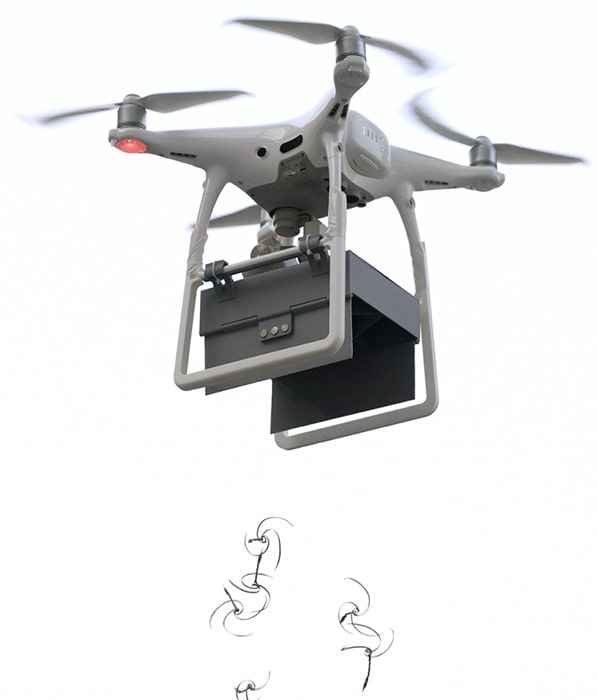
(Written by Byron Spice and Alex Dunbar)
Rolling Right Off
New research from Syracuse University shows how nanochannels, oil and candle soot could provide a water repelling surface with numerous applications.
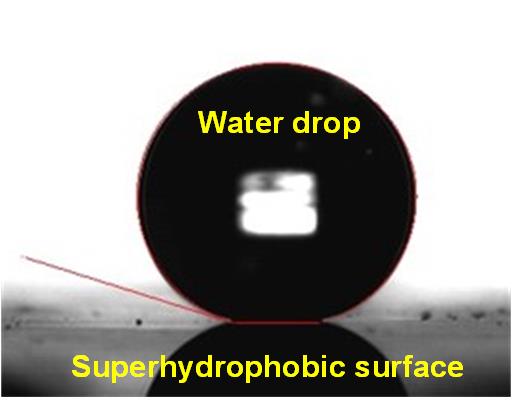
Surfaces that allow water or other liquids to roll right off are uniquely present in nature, such as on lotus leaves as well as on few aquatic insects, enabling them to walk on water or breathe under water by trapping a layer of air on their bodies. Such superhydrophobic surfaces can be helpful in a variety of engineering applications, ranging from coating of windshields and surgical tools, to steam turbines and condensers in power plants, and to improved hydrodynamics of submarines and ships.
Despite advancements in the development of artificially engineered superhydrophobic surfaces, durability and regenerative aspects of such surfaces remain elusive. Harsh working conditions including extreme exposure to water or humidity can deteriorate such surfaces especially after extended under-water usage.
Mechanical and aerospace engineering doctoral student Durgesh Ranjan and Professor Shalabh C. Maroo have developed a new approach for creating a durable superhydrophobic surface by first plasma-treating a fabricated porous nanochannel geometry on a silicon substrate followed by infusion-depletion of silicon oil and coating a layer of carbon derived from candle soot.

“We are able to engineer a superhydrophobic surface which is durable against high-speed water jets, non-sticky to many liquids ranging from water to honey, and stable under water for months,” says Maroo.
Research from Ranjan, Maroo and An Zou was published in the January 2023 issue of the high impact Chemical Engineering Journal and the technology is also patent pending. Their surface is capable of maintaining water contact angles of over 160° and roll off angle less than 5° even after undergoing 20 different tests, including chemical resistance to seawater and various solvents, high temperature exposure up to 570oF, condensation heat transfer, self-cleaning using fine all-purpose flour, frosting-defrosting cycles with ice, concentrated solar radiation exposure, and compatibility with organic products like honey, milk and syrup, thus exhibiting potential real-world applications.
Yi Zheng
Lab/ Center/ Institute affiliations:
BioInspired Institute
Areas of Expertise:
- Stem cell-based human developmental models
- Microengineered organ/disease models (organoids)
- Single cell genomics
- Microfluidics
- Mechanobiology
Embryonic development involves extensive lineage diversification, cell fate specification, tissue patterning and morphogenesis. Identification of the features that enable robust interpretation of developmental signaling using in vivo samples is a significant challenge. Recent studies of self-assembly processes of organ-like structures (organoids) from pluripotent stem cells in vitro have provided fresh insights into fundamental mechanisms underlying embryonic development. These stem cell-based in vitro models offer unparalleled opportunities for experimental control of key parameters, quantitative measurements, and mathematical modeling.
My lab sought to leverage sophisticated engineering approaches to achieve controllable in vitro platforms that could recapitulate sequential developmental events during human embryo development. These stem cell-based models will provide powerful experimental platforms to advance understanding of poorly understood embryonic disorders. With superior controllability and scalability, these platforms will also serve as effective tools for high-throughput drug and toxicity screening to facilitate diagnosis, prevention, and treatment of teratogenesis and birth defects.
Honors and Awards:
- Robert M. Caddell Memorial Award, University of Michigan
- Natural Sciences and Engineering Research Council of Canada (NSERC) Postdoctoral Fellowship
- Natural Sciences and Engineering Research Council of Canada (NSERC) CREATE Scholarships, University of Toronto
- Barbara and Frank Milligan Fellowships, University of Toronto
Selected Publications:
- Zheng Y, Yan RZ, Kobayashi M, Xiang L, Yang R, Goedel A, Kang Y, Xue X, Esfahani SN, Liu Y, Resto Irizarry AM, Wu W, Li Y, Ji W, Niu Y, Chien KR, Li T, Shioda T, Fu J. Single-cell analysis of embryoids reveals lineage diversification roadmaps of early human development. Cell Stem Cell. 2022. In Press
- Zheng Y, Xue X, Shao Y, Wang S, Esfahani SN, Li Z, Muncie JM, Lakins JN, Weaver VM, Gumucio DL, Fu J. Controlled modelling of human epiblast and amnion development using stem cells. Nature. 2019;573(7774):421-5.
- Zheng Y, Sun Y, Yu X, Shao Y, Zhang P, Dai G, Fu J. Angiogenesis in Liquid Tumors: An In Vitro Assay for Leukemic-Cell-Induced Bone Marrow Angiogenesis. Advanced Healthcare Materials. 2016;5(9):1014-24.
- Zheng Y, Chen J, Cui T, Shehata N, Wang C, Sun Y. Characterization of red blood cell deformability change during blood storage. Lab on a Chip. 2014;14(3):577-83.
- Zheng Y, Shojaei-Baghini E, Wang C, Sun Y. Microfluidic characterization of specific membrane capacitance and cytoplasm conductivity of single cells. Biosensors and Bioelectronics. 2013;42:496-502.
Younes Ra’di
Degrees:
Sc.D., Aalto University, 2015
Research Interests:
- Theoretical and Applied Electromagnetics
- RF and Microwave Engineering
- Antennas and Propagation
- Electromagnetics of Artificial Materials and Surfaces
Current Research:
His research is mainly focused on engineering fields and waves, with emphasis on tailoring electromagnetic wave-matter interactions. In this context, he has made several scientific contributions on a broad range of topics in theoretical and applied electromagnetics and optics, including engineered RF/microwave materials, antennas and propagation, functional metasurfaces, plasmonics, and nanophotonics. Working with three leading research groups in the field of engineering light-matter interaction, he has successfully put forward fundamentally new concepts and ideas to go beyond the limitations of conventional designs and have investigated theoretically, numerically, and experimentally innovative aspects of wave interaction with engineered structures.
Pankaj K. Jha
Degrees:
Ph. D., Physics, Texas A&M University
Masters of Science (5-Year Integrated), Physics, Indian Institute of Technology, Kanpur (IITK)
Areas of Expertise:
- Quantum information science
- Quantum sensing and metrology
- Quantum nano- and meta-photonics
- Bio-inspired materials
- Bio-nano interfaces
- Machine learning
Jha’s research focuses on developing quantum hardware using two-dimensional materials and heterostructures, III-V semiconductors, nanostructures, soft-materials, metamaterials, and hybrid combination of these materials. His research seeks to understand fundamental characteristics of these systems through combined experimental, theoretical, and computational studies and use those findings to gain control and induce novel optical, electrical, thermal, and mechanical responses in them. These responses, in turn, are leveraged to develop transformative devices and technologies for quantum information science, quantum sensing and metrology, nanophotonics, optoelectronics, and space exploration applications. Thus, his interdisciplinary research crosses the conventional scientific boundaries to merge applied physics with electrical engineering, materials science, and mechanical engineering.
Honors and Awards:
- Tingye Li Innovation Prize for Early Career Professionals (Finalist): 2016.
- American Physical Society, Travel Grant: 2011.
- Herman F. Heep and Minnie Belle Heep Foundation Graduate Fellowship: 2010.
- Robert A. Welch Foundation Graduate Fellowship: 2009-2012.
Selected Publications:
- P. K. Jha*, H. Akbari*, Y. Kim*, S. Biswas, and H. A. Atwater, “Nanoscale axial position and orientation measurement of hexagonal boron nitride quantum emitters using a tunable nanophotonic environment,” Nanotechnology 33, 015001 (2022).
- L. Kim*, S. Kim*, P. K. Jha, V. W. Brar, and H. A. Atwater, “Mid-Infrared radiative emission from bright hot plasmons in graphene,” Nat. Mater. 20, 805 (2021).
- H. Ramezani, P. K. Jha, Y. Wang, and X. Zhang, “Nonreciprocal Localization of Photons,” Phys. Rev. Lett. 120, 043901(2018).
- P. K. Jha, M. Mrejen, J. Kim, C. Wu, Y. Wang, Y. V. Rostovtsev, and X. Zhang, “Coherence-Driven Topological Transition in Quantum Metamaterials,” Phys. Rev. Lett. 116, 165502 (2016).
- P. K. Jha*, X. Ni*, C. Wu, Y. Wang, and X. Zhang, “Metasurface-Enabled Remote Quantum Interference,” Phys. Rev. Lett. 115, 025501 (2015).
- K. E. Dorfman, P. K. Jha, D. V. Voronine, P. Genevet, F. Capasso, and M. O. Scully, “Quantum-Coherence- Enhanced Surface Plasmon Amplification by Stimulated Emission of Radiation,” Phys. Rev. Lett. 111, 043601 (2013).
Anupam Pandey
Degrees:
- B.S. in Civil Engineering, Jadavpur University, 2010
- M.S. in Engineering Mechanics, Virginia Tech, 2014
- Ph.D. in Applied Physics, University of Twente, 2018
Areas of Expertise:
- Soft Matter
- Elasticity
- Capillarity
- Viscous flow
Lab/ Center/ Institute affiliation – BioInspired Institute
My primary research interest is understanding the mechanics of soft and squishy materials such as elastomers, hydrogels, and polymer melts. At a low energetic cost these materials can bend, fold, crease, pop or snap, exhibiting a variety of large (sometimes singular) and fast deformations. Their response emerge from an intricate coupling between geometry and material (surface and bulk) properties. Combining experimental, theoretical and numerical tools I study how soft materials behave when they are adhered to other substrates, wetted by liquid drops, or exposed to a flow. Leveraging this fundamental knowledge, my research lab aims to advance the development of flexible and wearable electronics, sensors and actuators for smart materials and functional surfaces.
Honors and Awards:
- Outstanding faculty award – Sigma Gamma Tau (2024).
- Active learning initiative fellowship at Cornell University (2021).
- International Congress of Theoretical and Applied Mechanics (ICTAM) Travel Award (2016).
Selected Publications:
- J. Yuk, A. Pandey, L. Park, W.E. Bemis and S. Jung, Effect of skull morphology on fox snow diving, PNAS 121, 19 (2024).
- A. Pandey, Z. Chen, J. Yuk, Y. Sun, C. Roh, D. Takagi, S. Lee and S. Jung, Optimal free surface pumping by an undulating carpet, Nature Communications 14, 7735 (2023).
- A. Pandey, J. Yuk, B. Chang, F. Fish, and S. Jung, Slamming dynamics of diving and its implications for diving related injuries, Science Advances 8, eabo5888, 2022.
- A. Pandey, M. Kansal, M. A. Herrada, J. Eggers and J. H. Snoeijer, Elastic Rayleigh-Plateau Instability: Dynamical Selection of Nonlinear States, Soft Matter, 17, 5148, 2021.
- A. Pandey, B. Andreotti, S. Karpitschka, G. J. van Zwieten, E. H. van Brummelen, and J. H. Snoeijer, Singular nature of the elastocapillary ridge, Physical Review X, 10, 031067, 2020.
Teng Zhang
Degree(s):
- Ph.D. Brown University, 2015
- M.S. Dalian University of Technology, 2010
- B.S. Dalian University of Technology, 2007
Lab/ Center Affiliation:
BioInspired Institute
Areas of Expertise:
- Solid mechanics
- Smart materials
- Mechanics of morphing
- Mechanics of instabilities
- Mechanics of interfaces
Dr. Zhang’s group’s research goal is to solve grand challenges where mechanics can play an important role and harness mechanics as an enabling tool to design smart materials and structures for future sustainability. Built on the core strength of mechanics, my group actively engages in highly interdisciplinary works, such as food design, smart materials, and biofilms. Examples of ongoing projects include:
- Harnessing instabilities and active materials to design reconfigurable structures
- Bio-inspired hybrid liquid and solid systems enabled by elasto-capillary and hygro-mechanical couplings
- Mechanics guided shape-changing food
- Mechanics of smart magnetic materials and structures
The fundamental mechanics understanding could also provide design principles of robotics and biomedical devices and establish virtual platforms for simulating and controlling them, especially for those with highly nonlinear deformation in complicated working environments (e.g., endovascular neurosurgery and smart catheters).
Honors and Awards:
- 2021 Soft Matter Emerging Investigator
- 2019 Faculty Early Career Development (CAREER) Award, National Science Foundation
- 2015 Outstanding thesis, Brown University’s School of Engineering
Selected Publications:
- Gabriel Alkuino, and Teng Zhang. Physics-based discrete models for magneto-mechanical metamaterials. Journal of the Mechanics and Physics of Solids (2024): 105759.
- Guangchao Wan, Samuel J. Avis, Zizheng Wang, Xueju Wang, Halim Kusumaatmaja, and Teng Zhang. Finding transition state and minimum energy path of bistable elastic continua through energy landscape explorations. Journal of the Mechanics and Physics of Solids 183 (2024): 105503.
- Danli Luo, Aditi Maheshwari, Andreea Danielescu, Jiaji Li, Yue Yang, Ye Tao, Lingyun Sun Guanyun Wang, Shu Yang, Teng Zhang, Lining Yao. Autonomous self-burying seed carriers for aerial seeding. Nature 614, no. 7948 (2023): 463-470.
- Ye Tao, Yi-Chin Lee, Haolin Liu, Xiaoxiao Zhang, Jianxun Cui, Catherine Mondoa, Mahnoush Babaei, Jasio Santillan, Guanyun Wang, Danli Luo, Di Liu, Humphrey Yang, Youngwook Do, Lingyun Sun, Wen Wang, Teng Zhang, and Lining Yao. Morphing Pasta and Beyond. Science Advances 7, no. 19 (2021): eabf4098.
- Oleh Tovkach, Junbo Chen, Monica M. Ripp, Teng Zhang, Joseph D. Paulsen, and Benny Davidovitch. Mesoscale structure of wrinkle patterns and defect-proliferated liquid crystalline phases. Proceedings of the National Academy of Sciences 117, no. 8 (2020): 3938-3943.
Yeqing Wang
Degree(s):
- Ph.D., University of Iowa
Areas of Expertise:
- Mechanics of composite materials and structures
- Durability and damage tolerance of composite structures
- Multifunctional composite materials
- Advanced manufacturing of composite materials
- Multiphysics modeling
Dr. Wang’s research goal is to understand the fundamental material behaviors and failure mechanisms of composite materials and structures under various loading conditions through mathematical modeling and experimental investigations, and then use the insights acquired to guide the design and development of novel multifunctional composite materials and structures (e.g., nanostructured, bioinspired) for improved durability and damage tolerance, as well as to guide the development and optimization of advanced manufacturing methods of composite structures.
Honors and Awards:
- Ralph E. Powe Junior Faculty Enhancement Award, Oak Ridge Associated Universities, 2020
- Graduate & Professional Student Government Travel Award, University of Iowa, 2016
- Second Place Award, IWEA (Iowa Wind Energy Association) Conference Research Poster Competition, 2014
- First Place Award, Paper Competition at the 15th Annual James F. Jakobsen Graduate Conference, University of Iowa, 2013
- First Place Award, Iowa EPSCoR Annual All-Hands Meeting Poster Competition, 2013
- Best Paper Award, 27th American Society for Composites (ASC) Technical Conference, 2012
Select Publications:
Yeqing Wang, Timothy K. Risch, Joseph H. Koo. Assessment of A One-dimensional Finite Element Charring Ablation Material Response Model for Phenolic-impregnated Carbon Ablator, Aerospace Science and Technology, 91:301-309, 2019.
Yeqing Wang, Getachew K. Befekadu, Hongtao Ding, David W. Hahn. Uncertainty Quantification for Modeling Pulsed Laser Ablation of Aluminum Considering Uncertainty in the Temperature-dependent Absorption Coefficients, Int. J. of Heat and Mass Transfer, 120:515-522, 2018.
Yeqing Wang, Crystal L. Pasiliao. Modeling Ablation of Laminated Composites: A Novel Manual Mesh Moving Finite Element Analysis Procedure with ABAQUS, Int. J. of Heat and Mass Transfer, 116:306-313, 2018.
Yeqing Wang, Olesya I. Zhupanska. Modeling of Thermal Response and Ablation in Laminated Glass Fiber Reinforced Polymer Matrix Composites Due to Lightning Strike, Applied Mathematical Modelling, 53:118-131, 2018.
Yeqing Wang. Multiphysics Analysis of Lightning Strike Damage in Laminated Carbon/Glass Fiber Reinforced Polymer Matrix Composite Materials: A Review of Problem Formulation and Computational Modeling, Composites Part A, 101:543-553, 2017.
Yeqing Wang, Ninggang Shen, Getachew K. Befekadu, Crystal L. Pasiliao. Modeling Pulsed Laser Ablation of Aluminum with Finite Element Analysis Considering Material Moving Front, Int. J. of Heat and Mass Transfer, 113:1246-1253, 2017.
Yeqing Wang, Olesya I. Zhupanska. Lightning Strike Thermal Damage Model for Glass Fiber Reinforced Polymer Matrix Composites and its Application to Wind Turbine Blades, Composite Structures, 132:1182-1191, 2015.
Radhakrishna (Suresh) Sureshkumar
Degrees:
- Ph.D. in Chemical Engineering, University of Delaware, 1996
- M.S. in Chemical Engineering, Syracuse University, 1992
- B. Tech. in Chemical Engineering, Indian Institute of Technology, 1990
Experience:
- Lecturer, Massachusetts Institute of Technology, 1996-97
- Assistant Professor (1997-2002), Associate Professor (2002-2006), and Professor (2006-2009) of Chemical Engineering, Washington University in St. Louis
- Visiting Professor, University of Michigan, Ann Arbor, 2008
- Visiting Professor, University of Edinburgh, Scotland, 2008
- Visiting Professor, University of Porto, Portugal, 2008
Lab/Center Affiliation(s):
- Multiscale Modeling and Simulation Laboratory
- Complex Fluids Laboratory
Research Interests:
- Complex Fluids
- Soft Condensed Matter
- Nanotechnology
- Smart Materials
- Sustainable Energy
- Multiscale Modeling and Simulation
Current Research:
Sureshkumar’s current research focuses on (i) understanding the structure, dynamics and rheology of complex fluids and soft matter, and (ii) nanoscale science and engineering of functional materials and interfaces. Multiscale modeling and simulations as well as experiments are used to probe the response of complex soft matter and interfaces to external stimuli such as mechanical deformation caused by flow, chemical/thermal gradients and optical fields. Major ongoing research efforts target investigations of self-assembly and self-organization routes to robust nanomanufacturing of optically tunable interfaces with applications to efficient light trapping in thin film photovoltaics, self-assembly of nanoparticles with surfactant micelles and polymers, interactions of nanoparticles with cell membranes to assess their cytotoxicity, rheology of viscoelastic polymer solutions/melts, coherent structures dynamics in turbulent flows in presence of drag reducing additives, bacterial biofilm mechanics as well as signaling between bacterial and mammalian cells.
Courses Taught:
- Chemical engineering methods
- Multiscale modeling and simulation
- Structure and rheology of complex fluids
Honors:
- Invited Speaker, University of Delaware Chemical Engineering Centennial Seminar Series, Newark, Delaware (2014)
- Keynote Speaker, International Congress on Rheology, Lisbon, Portugal (2012)
- Keynote Speaker, European Congress on Computational Methods in Applied Sciences and Engineering, Vienna, Austria (2012)
- Keynote Speaker, Lorentz Center Workshop on Flow Instabilities and Turbulence, Leiden, Netherlands (2010)
- University of Michigan Competitive Sabbatical Grant (2008)
- Royal Scottish Society of Edinburgh International Exchange Award, University of Edinburgh, Edinburgh, Scotland (2008)
- Distinguished Speaker, Department of Chemical and Biological Engineering, University of British Columbia, Vancouver, Canada (2008)
- Invited Speaker, American Physical Society Annual Meeting, Baltimore (2006)
- Invited Speaker, Materials Research Society Annual Meeting, Boston (2006)
- Invited Speaker, American Institute of Chemical Engineering, Salt Lake City (2007)
- National Science Foundation CAREER Award (1999)
- ACS/PRF New Faculty Grant (1998)
- University of Delaware Allan P. Colburn Prize, Outstanding Doctoral Dissertation in Engineering and Mathematical Sciences (1996)
- University of Delaware Competitive Fellowship (1995)
Student Awards:
- Graduate Student Poster Award (Mr. Tao Cong), Society of Rheology Annual Meeting, Cleveland, (2011)
- Graduate Student Poster Award (Dr. M. Vasudevan), Society of Rheology Annual Meeting, Salt Lake City, (2007)
- Graduate Student Poster Award (Dr. R. Magan), Colloids & Surface Chemistry Division, ACS Annual Meeting, Philadelphia (2004)
- Graduate Student Poster Award (Dr. R. Magan) Nanoscale S & E Forum, AIChE Annual Meeting, Austin (2004)
Selected Publications:
Sambasivam, A.V. Sangwai & R. Sureshkumar, Dynamics and scission of rod-like cationic surfactant micelles in shear flow, Phys. Rev. Lett., 114, 158302 (2015)
Dhakal & R. Sureshkumar, Topology, Length Scales and Energetics of Surfactant Micelles, J. Chem. Phys., 143, 024905 (2015)
S.C. DeSalvo, Y. Liu, G.S. Choudhary, D. Ren, S. Nangia & R. Sureshkumar, Signaling Factor Interactions with Polysaccharide Aggregates of Bacterial Biofilms, Langmuir, 31, 1958-66 (2015)
Estime, D. Ren & R. Sureshkumar, Effects of plasmonic film filters on microalgal growth and biomass composition, Algal Research, 11, 85-89 (2015)
Israelowitz, J. Amey, T. Cong & R. Sureshkumar, Spin Coated Plasmonic Nanoparticle Interfaces for Photocurrent Enhancement in Thin Film Si Solar Cells, Journal of Nanomaterials, Article ID 639458 (2014)
Kim & R. Sureshkumar, Spatiotemporal evolution of hairpin eddies, Reynolds stress, and polymer torque in polymer drag-reduced turbulent channel flows, Phys. Rev. E., 87, 063002 (2013)
Nangia & R. Sureshkumar, Effects of nanoparticle charge and shape anisotropy on translocation through cell membranes, Langmuir, 28, 1766-1771 (2012). Cover Article
Sangwai & R. Sureshkumar, Binary interactions and salt-induced coalescence of spherical micelles of cationic surfactants from molecular dynamics simulations, Langmuir, 28 (2), 1127–1135 (2012)
Cong, S.N. Wani & R. Sureshkumar, Structure and optical properties of self-assembled multicomponent plasmonic nanogels, Applied Physics Letters, 99, 043112 (2011)
Sangwai & R. Sureshkumar, Coarse-Grained Molecular Dynamics Simulations of the Sphere to Rod Transition in Surfactant Micelles, Langmuir, 27 (11), 6628–6638 (2011)
Torkamani, S. Wani, Y. Tang & R. Sureshkumar, Plasmon-enhanced microalgal growth in mini-photobioreactors, Applied Physics Letters, 97, 043703 (2010); Highlighted in Nature, 466 799 (2010)
Vasudevan, E. Buse, D. Lu, H. Krishna, R. Kalyanaraman, A.Q. Shen, B. Khomami & R. Sureshkumar, Irreversible nanogel formation in surfactant solutions by microporous flow, Nature Materials, 9, 436-441 (2010). Commentary by M. Pasquali, Nature Materials, 9, 381-382 (2010)
D.G. Thomas, B. Khomami & R. Sureshkumar, Nonlinear Dynamics of Viscoelastic Taylor-Couette Flow: Effect of Elasticity on Pattern Selection, Molecular Conformation and Drag, J. Fluid Mech., 620, 353-382 (2009).
Trice, C. Favazza, D.G. Thomas, H.G. Garcia, R. Kalyanaraman, R. Sureshkumar, A novel self-organization mechanism in ultrathin liquid films: theory and experiment, Phys. Rev. Lett., 101, 017802 (2008)
Kim, R.J. Adrian, S. Balachandar & R. Sureshkumar, Dynamics of hairpin vortices and polymer-induced turbulent drag reduction, Phys. Rev. Lett., 100, 134504 (2008)
C M. Vasudevan, A.Q. Ashen, B. Khomami & R. Sureshkumar, Self-similar shear-thickening behavior in CTAB/NaSal surfactant solutions, J. Rheol., 52, 527-50 (2008)
Pranav Soman
Degree(s):
Ph.D. Bioengineering (Penn State University)
Lab/ Center/ Institute affiliation:
- BioInspired Institute
- Biomaterial Institute
Areas of Expertise:
- Optical printing
- Bioprinting
- Microfluidics
- Organ-On-Chip
- Tissue engineering
Nature’s marvelous ability to arrange proteins, sugars, and minerals from macro to nano scales has realized a wide range of ‘smart’ multifunctional structures optimized to satisfy specific environmental demands. Man-made manufacturing, however, is not able to match nature’s building capabilities. My central research focus is to develop new processing and printing technologies to create reliable models from single cell to tissue scale to capture key aspects of in vivo physiology and pathophysiology. Toward this goal, my group, with expertise in mechanical engineering, laser optics, biomaterials and cell biology, has developed a technology toolbox to process and print biocompatible thermoplastics, photosensitive hydrogels, and living cells and provide a manufacturing solution to advance research in bioprinting, microfluidics, organ-on-chip, tissue engineering, regenerative medicine, and single cell analysis.
Honors and Awards:
- 2022 The U.S. Air Force Research Lab Summer Faculty Fellowship Program
- 2021 Satish Dhawan Visiting Chair Professor at the Indian Institute of Science
- 2020 Techconnect Defense Innovation Award
- 2020 E&T Outstanding Innovation in the Manufacturing 4.0
- 2015 Syracuse University – College of Engineering and Computer Science Award for Faculty Excellence
- 2010 Dean’s award for academic excellent, Penn State University.
- 2015 Faculty Excellent Award, Syracuse University
Selected Publications:
Xiong, Z., Kunwar, P., & Soman, P. (2021). Hydrogel‐Based Diffractive Optical Elements (hDOEs) Using Rapid Digital Photopatterning. Advanced optical materials, 9(2), 2001217.
Kunwar, P., Jannini, A.V.S., Xiong, Z., Ransbottom, M.J., Perkins, J.S., Henderson, J.H., Hasenwinkel, J.M. and Soman, P., 2019. High-resolution 3D printing of stretchable hydrogel structures using optical projection lithography. ACS Applied Materials & Interfaces.
Kunwar, P., Xiong, Z., Zhu, Y., Li, H., Filip, A. and Soman, P., 2019. Hybrid Laser Printing of 3D, Multiscale, Multimaterial Hydrogel Structures. Advanced Optical Materials, p.1900656.
Xiong, Z., Li, H., Kunwar, P., Zhu, Y., Ramos, R., Mcloughlin, S., Winston, T., Ma, Z. and Soman, P., 2019. Femtosecond laser induced densification within cell-laden hydrogels results in cellular alignment. Biofabrication, 11(3), p.035005.
Sawyer, S. W., Shridhar, S. V., Zhang, K., Albrecht, L., Filip, A., Horton, J., & Soman, P. (2018). Perfusion directed 3D mineral formation within cell-laden hydrogels. Biofabrication. June 8.
Wanliang Shan
Degrees:
- Ph.D. Princeton University
- B.E. University of Science & Technology of China (USTC)
Areas of Expertise:
- Solid Mechanics
- Materials Engineering
- Soft Robotics
- Machine Learning
- Thermophysics
Lab/Center Affiliation:
- BioInspired Institute
Current Research:
Shan Research Group (SRG) focuses on interdisciplinary research in Smart, Hybrid, Active and Nature-inspired Materials, Mechanics, and Machines (SHAN 3M). Fundamental insights from solid mechanics, materials engineering, thermal science, and machine learning are emphasized for the design and fabrication of soft multifunctional materials and high-performance robotic mechanisms, which impact critical application domains such as soft robotics, biomedical devices, and wearable devices. The ultimate goal of SRG’s research is to improve human-machine-environment interactions.
Teaching Interests:
- Introduction to Robotics
- Soft Robotics
- Continuum Mechanics
- Fracture Mechanics
Honors and Awards:
- NSF Career Award (2023)
- Graduate with Great Honor (magna cum laude), USTC (2006)
Select Publications:
* for corresponding authors. ◦ for co-first authors.
- C. Zhao, K.T. Wan*, W.L. Shan*, Progressive Adhesion Mechanics of Elastomeric Shells against a Rigid Substrate: from Thin to Thick, Extreme Mechanics Letters, 68:102140, 2024.
- G. Wan, W.L. Shan*, Pneumatically Tunable Adherence of Elastomeric Soft Hollow Pillars with Non-Circular Contact, International Journal of Solids and Structures, 294:112736, 2024.
- G. Wan, Y. Tang, K.T. Turner, T. Zhang*, W.L. Shan*, Tunable Dry Adhesion of Soft Hollow Pillars through Sidewall Buckling under Low Pressure, Advanced Functional Materials, 33(2):2209905, 2023.
- C. Zhao, X. Chen, W.L. Shan*, K.T. Wan*, Adherence of a Hyperelastic Shell on a Rigid Planar Substrate. International Journal of Solids and Structures, 236:111351, 2022.
- A. Mohammadi Nasab, A. Luo, P. Stampfli, S. Sharifi, K.T. Turner*, W.L. Shan*, Dynamically Tunable Dry Adhesion Through a Subsurface Thin Layer with Tunable Stiffness. Advanced Materials Interfaces, 9(7):2102080, 2022.
- S. Sharifi, C. Rux, N. Sparling, G. Wan, A. Mohammadi Nasab, A. Siddaiah, P. Menezes, T. Zhang, W.L. Shan*, Dynamically Tunable Friction via Subsurface Stiffness Modulation, Frontiers in Robotics and AI, 8:691789, 2021.
- A. Mohammadi Nasab, S. Sharifi, S. Chen, W.L. Shan*, Robust three-component elastomer-particle-fiber composites with tunable properties for soft robotics, Advanced Intelligent Systems, 3:2000166, 2021.
- A. Mohammadi Nasab, A. Luo, S. Sharifi, K.T. Turner*, W.L. Shan*, Soft Gripping Device Based on Pneumatics-Modulated Tunable Dry Adhesion, ACS Applied Materials and Interfaces, 2020.
- A. Luo◦, A. Mohammadi Nasab◦, M. Tatari, S. Chen, W.L. Shan*, K.T. Turner*. Adhesion of flat-ended pillars with non-circular contacts, Soft Matter, 2020. Link
- M. Tatari, A. Mohammadi Nasab, K.T. Turner*, W.L. Shan*, Dynamically Tunable Dry Adhesion via Sub-Surface Stiffness Modulation, Advanced Materials Interfaces, 5:1800321, 2018.
- A. Mohammadi Nasab, D. Wang, Z. Chen, W.L. Shan*, Buckling Shape Transition of an Embedded Thin Elastic Rod after Failure of Surrounding Elastic Medium, Extreme Mechanics Letters, 15:51-56, 2017.
- A. Mohammadi Nasab◦, A. Sabzehzar◦, M. Tatari, C. Majidi, W.L. Shan*, A Soft Gripper with Rigidity Tunable Elastomer Strips as Ligaments, Soft Robotics, 2017.
- A. Tutcuoglu, C. Majidi*, W.L. Shan*, Nonlinear Thermal Parameter Estimation for Embedded Internal Joule Heaters, International Journal of Heat and Mass Transfer, 97:12-421, 2016.
Dacheng Ren
Degrees:
- B.E. (major) Applied Chemistry, Shanghai Jiao Tong University, P. R. China, 1996.
- B.E. (minor) Electrical Engineering, Shanghai Jiao Tong University, P. R. China, 1996.
- M.E. Chemical Engineering, Tianjin University, P. R. China, 1999.
- Ph.D. Chemical Engineering, University of Connecticut, Storrs, CT, 2003
- Postdoctoral associate, Chemical Engineering, Cornell University, Ithaca, NY, 2003-2005.
Lab/Center Affiliation:
- Syracuse BioInspired Institute
Areas of Expertise:
- Biomaterials
- Medical devices
- Biotechnology
- Synthetic Biology
- Bacterial control
Current Research:
Historically, our understanding of bacterial physiology and development of antibiotics have been focused on active planktonic (free-swimming) cells. However, the vast majority of bacteria in nature and medical environments exist in surface-attached biofilms with varying levels of dormancy. With up to 1,000 times higher tolerance to antibiotics and disinfectants compared to their planktonic counterparts, deleterious biofilms cause serious problems such as chronic infections in humans as well as persistent fouling and equipment failure in industry. Biofilms are blamed for billions of dollars of losses and more than 45,000 deaths annually in the U.S. alone. Despite the well-recognized significance of biofilms, the mechanisms of biofilm formation and bacterial dormancy are still not fully understood with many fundamental questions unanswered. Controlling biofilms and dormant cells is also challenging. To address these challenges, we conduct both basic and translational research with specific interests in bacteria-material interactions, novel antifouling materials, new agents for controlling biofilms and dormant cells, synthetic biology for microbial control, and smart and safer medical devices.
Courses Taught:
- CEN551 Biochemical Engineering
- BEN301 Biological Principles for Engineers
Honors:
- Fellow, American Institute for Medical and Biological Engineering (AIMBE), 2022
- Chancellor’s citation for Faculty Excellence & Scholarly Distinction, Syracuse University, 2018
- Faculty Excellence Award, School of Engineering & Computer Science, Syracuse University, 2014
- NSF CAREER Award, 2011-2016
- College Technology Educator of the Year by the Technology Alliance of Central New York (TACNY), 2010.
- Early Career Translational Research Award in Biomedical Engineering, Wallace H. Coulter Foundation, 2009
Selected Publications:
For a full list of publications, please see http://scholar.google.com/citations?user=85Ty0hAAAAAJ&hl=en&oi=ao.
Yikang Xu and Dacheng Ren. “A novel inductively coupled capacitor wireless sensor system for rapid antibiotic susceptibility testing.” Journal of Biological Engineering. 17, Article number: 54 (2023).
72. Sang Won Lee, Erick L. Johnson, J. Alex Chediak, Hainsworth Shin, Yi Wang, K. Scott Phillips and Dacheng Ren. “High-Throughput Biofilm Assay to Investigate Bacterial Interactions with Surface Topographies.” ACS Applied Bio Materials. 5: 3816-3825 (2022).
Sweta Roy, Ali Adem Bahar, Huan Gu, Shikha Nangia, Karin Sauer and Dacheng Ren. “Persister Control by Leveraging Dormancy Associated Reduction of Antibiotic Efflux.” PLOS Pathogens. 17(12): e1010144 (2021).
Sang Won Lee, Joseph Carnicelli, Dariya Getya, Ivan Gitsov, K. Scott Phillips and Dacheng Ren. “Biofilm Removal by Reversible Shape Recovery of the Substrate.” ACS Applied Materials & Interfaces. 13 (15): 17174–17182 (2021)
Sang Won Lee, K. Scott Phillips, Huan Gu, Mehdi Kazemzadeh-Narbat, Dacheng Ren. “How microbes read the map: effects of implant topography on bacterial adhesion and biofilm formation.” Biomaterials. 268: 120595 (2021).
Huan Gu, Sang Won Lee, Joseph Carnicelli, Teng Zhang, and Dacheng Ren. “Magnetically driven active topography for long-term biofilm control”. Nature Communications. 11: Article number: 2211 (2020).
Yikang Xu, Yousr Dhaouadi, Paul Stoodley, and Dacheng Ren, “Sensing the unreachable: challenges and opportunities in biofilm detection”. Current Opinion in Biotechnology. 64: 79-84 (2020).
Zhao Qin
Degrees:
- Ph.D., Civil and Environmental Engineering, Massachusetts Institute of Technology, 2013.
- M.Eng., Engineering Mechanics, Tsinghua University, Beijing, China, 2008.
- B.Eng., Engineering Mechanics, Tsinghua University, Beijing, China, 2006.
Research interests:
- Development of advanced computational modeling methods for designing new materials of advanced material functions.
- Bottom-up modeling of the multi-scale structure-mechanics relationship of nano- and bio-materials. Fundamental understanding of the material behaviors of biological and synthetic polymeric materials from the most molecular scale to macroscopic length scale.
- Learn from nature and discover bio-inspired ideas to create and design materials with innovative material functions.
- Prototyping, optimization and characterization of synthetic composite materials with multiple advanced material functions, for efficient usage of engineering materials.
Current Research:
My research focuses on developing advanced computational modeling methods, using them to study fundamental mechanical properties of biological materials and applying the knowledge to design new materials of advanced mechanical functions. I have a broad background in mechanics and structure of materials, with specific training and expertise in the multi-scale structure-mechanics relationship in biological materials. My research focuses on the structure and mechanics insight of general natural materials as many of them, such as mussel glue, insect wings and membranes, have fascinating mechanical and biological properties built up from simple basic molecular building blocks. I am thus strongly motivated to develop tools that enable us to learn from nature to make material innovations more efficient. I have developed a multi-scale high-throughput computational modeling method that enables me to study materials from the most fundamental molecular scale to macroscopic length scale. I have applied the tool to the investigations of several different biological materials and have revealed new mechanisms hidden in their complex structures. Some of the findings contribute to fundamental understandings of diseases that take place from the molecular scale; others contribute to designs and prototyping of synthetic composite materials with multiple advanced material functions. I have developed principles to help to optimize the material functions through structures, making it feasible to rationally design the mechanics and longevity of composite materials, leading to better performance with less energetic and environmental cost than conventional engineering materials for industrial applications.
Courses Taught:
- CEE 325 – Mechanics of Materials
- CEE 676 – Multiscale Material Modeling and Simulations
Honors:
- National Science Foundation CAREER Award, NSF, May 2022
- 2021 Fellowship to 25th International Congress of Theoretical and Applied Mechanics (ICTAM 2020+1) from USNC/TAM.
- 2020 Collaboration for Unprecedented Success and Excellence (CUSE) Grant, Syracuse University
- Best paper award in Journal of Applied Mechanics (ASME) for the paper “Bioinspired Graphene Nanogut” among papers published during 2012-2013
- Outstanding Paper Award, ASME Global Congress on Nano Engineering for Medicine and Biology, Boston, MA, 2013
- Chinese Government Award For Outstanding Self-Financed Students Abroad, NY, 2011
- Best Paper Award, International Journal of Applied Mechanics (Imperial College Press) 2010
- Schoettler Graduate Fellowship, Civil and Environmental Engineering, MIT, 2010
- SAMSUNG Scholarship, Tsinghua University, China, 2007
- 2nd Rank National Scholarship, Tsinghua University, China, 2003
Recent Publications:
DA Qureshi, S Goffredo, Y Kim, Y Han, M Guo, S Ryu, Z Qin (2022) Why mussel byssal plaques are tiny yet strong in attachment, Matter, 5, 710-724
S Liu, K Duan, J Feng, L Li, X Wang, Y Hu, Z Qin (2022), The design of strongly bonded nanoarchitected carbon materials for high specific strength and modulus, Carbon, 195, 387-394
R Xu, L Yang, Z Qin (2022), Design, manufacture, and testing of customized sterilizable respirator, Journal of the Mechanical Behavior of Biomedical Materials, 131, 105248
L Yang, D Park, Z Qin (2021), Material Function of Mycelium Based Bio-composite: A Review, Frontiers in Materials, 8, 374
J Cui, M Jiang, M Nicola, A Masic, Z Qin (2021), Multiscale understanding in fracture resistance of bamboo skin, Extreme Mechanics Letters, 49, 101480
J-K Qin, C Sui, Z Qin, J Wu, H Guo, L Zhen, C-Y Xu, Y Chai, C Wang, X He, P D Ye, J Lou (2021), Mechanical anisotropy in two-dimensional selenium atomic layers, Nano Letters, 21, 8043-8050
J. L. Kessler, G. Kang, Z. Qin, H. Kang, F. G. Whitby, T. E. Cheatham, C. P. Hill, Y. Li, and S. Michael Yu (2021), Peptoid Residues Make Diverse, Hyperstable Collagen Triple-Helices, J. Am. Chem. Soc., 143, 29, 10910–10919
J Ni, S. Lin, Z. Qin, D. Veysset, X. Liu, Y. Sun, A.J. Hsieh, R. Radovitzky, K.A. Nelson, X. Zhao (2021), Strong Fatigue-Resistant Nanofibrous Hydrogels Inspired by Lobster Underbelly, Matter, 4, 1919–1934.
Q Huang, T Deng, W Xu, CK Yoon, Z Qin, Y Lin, Tengfei Li, Y. Yang, M Shen, S M. Thon, J B. Khurgin, D H. Gracias (2020), Solvent Responsive Self‐Folding of 3D Photosensitive Graphene Architectures, Adv. Intell. Syst., 2020, 2000195
K Tanuj Sapra, Z Qin, A Dubrovsky-Gaupp, U Aebi, D J Müller, M J Buehler, O Medalia (2020), Nonlinear mechanics of lamin filaments and the meshwork topology build an emergent nuclear lamina, Nature Communications, 11, 6205
X Guo, L Zhao, Z Qin, L Wu, A Shehu, Y Ye (2020), Interpretable Deep Graph Generation with Node-Edge Co-Disentanglement, Proceedings of the 26th ACM SIGKDD International Conference on Knowledge Discovery & Data Mining, 1697-1707
JL Zitnay, GS Jung, AH Lin, Z Qin, Y Li, SM Yu, MJ Buehler, JA Weiss (2020), Accumulation of collagen molecular unfolding is the mechanism of cyclic fatigue damage and failure in collagenous tissues, Science Advances, 6, eaba2795
G Grezzana, HC Loh, Z Qin, MJ Buehler, A Masic, F Libonati, Probing the Role of Bone Lamellar Patterns through Collagen Microarchitecture Mapping, Numerical Modeling, and 3D‐Printing (2020), Advanced Engineering Materials, 2000387
J Cui, Z Qin, A Masic, MJ Buehler, Multiscale structural insights of load bearing bamboo: A computational modeling approach (2020), Journal of the Mechanical Behavior of Biomedical Materials, 107, 103743
Z Qin, Q Yu, MJ Buehler, Machine learning model for fast prediction of the natural frequencies of protein molecules (2020), RSC Advances, 10, 16607-16615
B Azimi, M. Milazzo, A. Lazzeri, S. Berrettini, M.J. Uddin, Z. Qin, M.J. Buehler, S. Danti, Electrospinning piezoelectric fibers for biocompatible devices (2020), Advanced Healthcare Materials, 9, 1901287
Z Qin, L Wu, H Sun, S Huo, T Ma, E Lim, P-Y Chen, B Marelli, M J Buehler (2020), Artificial intelligence method to design and fold alpha-helix structural proteins from the primary amino acid sequence, Extreme Mechanics Letters, 36, 100652
J Liu, S Lin, X Liu, Z Qin, Y Yang, J Zang, and X Zhao (2020), Fatigue-resistant Adhesion of Hydrogels, Nature Communications, 11, 1071
J Wu, Z Qin, L Qu, H Zhang, F Deng, M Guo (2019), Natural hydrogel in American lobster: a soft armour with high toughness and strength, Acta Biomaterialia, Vol 88, pp. 102-110
Y Han, M-Y Li, G-S Jung, M A. Marsalis, Z Qin, M J. Buehler, L-J Li, D A. Muller (2018), Sub-Nanometer Channels Embedded in Two-Dimensional Materials, Nature Materials, Vol. 17, pp 129-133
Z Qin, G S Jung, M J Kang, M J. Buehler (2017), The mechanics and design of light-weight three-dimensional graphene assembly, Science Advances, Vol. 3, paper #: e1601536
Quinn Qiao
Degrees:
- Ph.D. Virginia Commonwealth University, 2006
- M.S. Shanghai Institute of Optics and Fine Mechanics, Chinese Academy of Science, 2003
- B.S. Hefei University of Technology, Hefei, 1999
Center Affiliation: NSF IUCRC Center for Solid-State Electric Power Storage (CEPS)
Research Interests:
- Batteries
- Solar cells
- Micro/ nano fabrication
- Biomedical sensors
- Precision agriculture
Dr. Quinn Qiao is a professor in the department of mechanical and aerospace engineering and an affiliate professor in the department of electrical engineering and computer science at Syracuse University. He is the site director for the NSF Industry University Cooperative Research Center (IUCRC) for Solid State Electric Power Storage (CEPS), and SU campus lead for NSF Engine project. Before moving to Syracuse University, he was the Harold C. Hohbach Professor of Electrical Engineering at South Dakota State University and the Director of the U.S. Economic Development Center at the University. He has also been working on batteries (lithium ion, lithium metal, solid state, etc.), solar cells, and biosensors. He has published more than 300 peer reviewed papers in leading journals including Science, Nature Communications, Energy and Environmental Science, Journal of the American Chemical Society, Advanced Materials, Advanced Energy Materials, Advanced Functional Materials, Nanoscale, Joule, ACS Energy Letters, Nano Energy, IEEE Sensors Journal, IEEE Transactions on Electron Devices, IEEE Journal of Photovoltaics, IEEE Electron Device Letters, etc. He has more than 16,200 citations on Google Scholar and a H-index of 69.
Honors:
- 2019 Commercialization Award, SDSU
- 2016 Faculty Excellence for Global Engagement in International Research, SDSU
- 2015 Distinguished Researcher of the Year, SDSU
- 2014 F O Butler Award for Excellence in Research, SDSU
- 2014 Visiting Professorship from Hefei University of Technology, China.
- 2013 Best Poster Award at 3rd International Conference on Nanotek and Expo, Las Vegas, NV, USA.
- 2012 Best Paper Award, Inter-Continental Advanced Materials for Photonics (I-CAMP) Summer School on renewable and sustainable energy
- 2012 3M Non-tenured Faculty Award
- 2012 Young Investigator Award
- 2010 NSF CAREER Award
- 2009 Bergmann Memorial Research Award from US-Israel Binational Science Foundation
- 2009 Doctor New Investigator Award from American Chemical Society Petroleum Research Fund
- 2006 Chinese Government Award for Outstanding Self-financed Student Abroad, China Scholarship Council (CSC)
- 2006 ASME Solar Energy Division Graduate Student Award
Select Publications:
Sung-Doo Baek, Wenhao Shao, Weijie Feng, Yuanhao Tang, Yoon Ho Lee, James Loy, William B Gunnarsson, Hanjun Yang, Yuchen Zhang, M Bilal Faheem, Poojan Indrajeet Kaswekar, Harindi R Atapattu, Jiajun Qin, Aidan H Coffey, Jee Yung Park, Seok Joo Yang, Yu-Ting Yang, Chenhui Zhu, Kang Wang, Kenneth R Graham, Feng Gao, Quinn Qiao, L Jay Guo, Barry P Rand, Letian Dou, Grain engineering for efficient near-infrared perovskite light-emitting diodes, Nature Communications volume 15, Article number: 10760 (2024).
Zeyu Chen, Fan Wu, Rajesh Pathak, Lu Chen, Jinxin Bian, Sally Mabrouk, Jeffrey W Elam, Quinn Qiao, In Situ Exploration of Dipole Field Effects on Weak Hysteresis in 3D/2D Perovskites, Adv. Electron. Mater. 10, 2400107, 2024.
Tarif Anam, Md Tawabur Rahman, Liang Dong, Quinn Qiao, Low-Temperature Detection of Carbon Monoxide With Enhanced Sensitivity Using Ag-Loaded ZnO/rGO-Modeling, Simulation, and Validation, IEEE Sensors Journal, 18827 – 18834, 24 (12), 2024.
Hanjie Lin, Shuya Li, Yuchen Zhang, Chun Chu, Walker MacSwain, Robert W Meulenberg, Quinn Qiao, Dong Zhao, Weiwei Zheng, Epitaxial Growth of Lead-Free Double Perovskite Shell for CsPbX3/Cs2SnX6 (X = Cl, Br, and I) Core/Shell Perovskite Nanocrystals with Enhanced Photoelectric Properties and Stability, Adv. Funct. Mater. 2024, 34, 2309480.
Jinyu Zhao, Rajesh Pathak, Zhenxin Zhao, Xu Chen, Madan Bahadur Saud, Hansheng Li, Fan Wu, Quinn Qiao, Jeffrey W Elam, Xiaomin Wang, Advanced nano-bifunctional electrocatalyst in Li-air batteries for high Coulombic efficiency, Green Chem., 2023,25, 10182-10208.
Quasi‐homojunction organic nonfullerene photovoltaics featuring fundamentals distinct from bulk heterojunctions, Yifan Wang, Michael B Price, Raja Sekhar Bobba, Heng Lu, Jingwei Xue, Yilin Wang, Mengyang Li, Aleksandra Ilina, Paul A Hume, Boyu Jia, Tengfei Li, Yuchen Zhang, Nathaniel JLK Davis, Zheng Tang, Wei Ma, Quinn Qiao, Justin M Hodgkiss, Xiaowei Zhan, Advanced Materials 34 (50), 2206717, 2022.
Yifan Wang, Michael B Price, Raja Sekhar Bobba, Heng Lu, Jingwei Xue, Yilin Wang, Mengyang Li, Aleksandra Ilina, Paul A Hume, Boyu Jia, Tengfei Li, Yuchen Zhang, Nathaniel JLK Davis, Zheng Tang, Wei Ma, Quinn Qiao, Justin M Hodgkiss, Xiaowei Zhan, Simultaneously enhancing exciton/charge transport in organic solar cells by an organoboron additive, Advanced Materials 34 (42), 2205926, 2022.
M Bilal Faheem, Bilawal Khan, Jaweria Z Hashmi, Abiral Baniya, WS Subhani, Raja Sekhar Bobba, Abdullah Yildiz, Quinn Qiao, Insights from scalable fabrication to operational stability and industrial opportunities for perovskite solar cells and modules, Cell Reports Physical Science 3 (4), 2022
Rajesh Pathak, Ke Chen, Fan Wu, Anil U Mane, Ratnakumar V Bugga, Jeffrey W Elam, Quinn Qiao, Yue Zhou, Advanced strategies for the development of porous carbon as a Li host/current collector for lithium metal batteries, Energy Storage Materials 41, 448-465, 2021
Wei He, Ke Chen, Rajesh Pathak, Matthew Hummel, Khan Mamun Reza, Nabin Ghimire, Jyotshna Pokharel, Shun Lu, Zhengrong Gu, Qiquan Qiao, Yue Zhou, High-mass-loading Sn-based anode boosted by pseudocapacitance for long-life sodium-ion batteries, Chemical Engineering Journal 414, 128638, 2021.
Zhenxin Zhao, Zonglin Yi, Huijun Li, Rajesh Pathak, Xiaoqin Cheng, Junliang Zhou, Xiaomin Wang, Qiquan Qiao, Understanding the modulation effect and surface chemistry in a heteroatom incorporated graphene-like matrix toward high-rate lithium–sulfur batteries, Nanoscale 13 (35), 14777-14784, 2021
Yi Hou, Erkan Aydin, Michele De Bastiani, Chuanxiao Xiao, Furkan H Isikgor, Ding-Jiang Xue, Bin Chen, Hao Chen, Behzad Bahrami, Ashraful H Chowdhury, Andrew Johnston, Se-Woong Baek, Ziru Huang, Mingyang Wei, Yitong Dong, Joel Troughton, Rawan Jalmood, Alessandro J Mirabelli, Thomas G Allen, Emmanuel Van Kerschaver, Makhsud I Saidaminov, Derya Baran, Qiquan Qiao, Kai Zhu, Stefaan De Wolf, Edward H Sargent, Efficient tandem solar cells with solution-processed perovskite on textured crystalline silicon, Science, 367 (2020) 1135-1140.
Rajesh Pathak, Ke Chen, Ashim Gurung, Khan Mamun Reza, Behzad Bahrami, Jyotshna Pokharel, Abiral Baniya, Wei He, Fan Wu, Yue Zhou, Kang Xu, Qiquan Quinn Qiao, Fluorinated hybrid solid-electrolyte-interphase for dendrite-free lithium deposition, Nature Communications, 11 (2020) 1-10.
Yinhua Lv, Ruihan Yuan, Bing Cai, Behzad Bahrami, Ashraful Haider Chowdhury, Chi Yang, Yihui Wu, Qiquan Qiao, Shengzhong Liu, Wen-Hua Zhang, Angew. Chem. Int. Ed., (2020). doi:10.1002/anie.201915928
Yilei Wu, Sebastian Schneider, Christopher Walter, Ashraful Haider Chowdhury, Behzad Bahrami, Hung-Chin Wu, Qiquan Qiao, Michael F Toney, Zhenan Bao, Fine-Tuning Semiconducting Polymer Self-Aggregation and Crystallinity Enables Optimal Morphology and High-Performance Printed All-Polymer Solar Cells, J. Am. Chem. Soc., 2020, 142, 1, 392-406.
Md Ashiqur Rahman Laskar, Wenqin Luo, Nabin Ghimire, Ashraful Haider Chowdhury, Behzad Bahrami, Ashim Gurung, Khan Mamun Reza, Rajesh Pathak, Raja Sekhar Bobba, Buddhi Sagar Lamsal, Ke Chen, Md Tawabur Rahman, Sheikh Ifatur Rahman, Khalid Emshadi, Tingting Xu, Mao Liang, Wen‐Hua Zhang, Qiquan Qiao, Phenylhydrazinium Iodide for Surface Passivation and Defects Suppression in Perovskite Solar Cell, Advanced Functional Materials, 2020, 2000778. https://doi.org/10.1002/adfm.202000778
Rajesh Pathak, Ke Chen, Ashim Gurung, Khan Mamun Reza, Behzad Bahrami, Fan Wu, Ashraf Chaudhary, Nabin Ghimire, Bin Zhou, Wen‐Hua Zhang, Yue Zhou, Qiquan Qiao, Ultrathin Bilayer of Graphite/SiO2 as Solid Interface for Reviving Li Metal Anode, Advanced Energy Materials, 9 (2019) 1901486.
Fan Wu, Rajesh Pathak, Ke Chen, Guiqiang Wang, Behzad Bahrami, Wen-Hua Zhang, Qiquan Qiao, Inverted Current-Voltage Hysteresis in Perovskite Solar Cells, ACS Energy Letters, 3(10):2457-2460, 2018.
Hytham Elbohy, Behzad Bahrami, Sally Mabrouk, Khan Mamun Reza, Ashim Gurung, Rajesh Pathak, Mao Liang, Qiquan Qiao, and Kai Zhu. Tuning Hole Transport Layer Using Urea for High‐Performance Perovskite Solar Cells. Advanced Functional Materials, 2019, 29, 1806740. https://doi.org/10.1002/adfm.201806740.
Evan T Vickers, Thomas A Graham, Ashraful H Chowdhury, Behzad Bahrami, Benjamin W Dreskin, Sarah Lindley, Sara Bonabi Naghadeh, Qiquan Qiao, Jin Z Zhang, Improving charge carrier delocalization in perovskite quantum dots by surface passivation with conductive aromatic ligands, ACS Energy Letters, 3 (2018) 2931-2939.
Ashim Gurung, Qiquan Qiao, Solar Charging Batteries: Advances, Challenges, and Opportunities, Joule, 2 (7), 1217-1230, 2018.
Md Faisal Kabir, Md Tawabur Rahman, Ashim Gurung, and Qiquan Qiao, Electrochemical Phosphate Sensors using Silver Nanowires Treated Screen Printed Electrodes, IEEE Sensors Journal, 18 (9), 3480-3485, 2018.
Upendra Neupane, Behzad Bahrami, Matt Biesecker, Mahdi Farrokh Baroughi, and Qiquan Qiao, Kinetic Monte Carlo Modeling on Organic Solar Cells: Domain Size, Donor-Acceptor Ratio and Thickness, Nano Energy, 35, 128-137, 2017.
Roya Naderi, Ashim Gurung, Zhengping Zhou, Geetha Varnekar, Ke Chen, Jiantao Zai, Xuefeng Qian, Qiquan Qiao, Activation of passive nano-fillers in composite polymer electrolyte for higher performance lithium ion batteries, Advanced Sustainable Systems, 1, 8, 1700043, 2017.
Ashim Gurung, Ke Chen, Geetha Varnekar, Reza Khan, Salem Saad Abdulkarim, Rajesh Pathak, Roya Naderi, Qiquan Qiao, Highly Efficient Perovskite Solar Cell Photo-Charging of Lithium Ion Battery using DC-DC Booster, Advanced Energy Materials, 1602105, 2017.
Mukesh Kumar, Ashish Dubey, Nirmal Adhikari, Swaminathan Venkatesan and Qiquan Qiao, Strategic review of secondary phases, defects and defect-complexes in kesterite CZTS-Se solar cells, Energy & Environmental Science, 8, 3134-3159, 2015.
Qi Wang, Iain W. H. Oswald, Xiaolong Yang, Guijiang Zhou, Huiping Jia, , Qiquan Qiao, Yonghua Chen, Jason Hoshikawa-Halbert, Bruce E. Gnade, A Non-Doped Phosphorescent Organic Light-Emitting Device with Above 31% External Quantum Efficiency, Advanced Materials, 26: 8107–8113, 2014, doi: 10.1002/adma.201402947 .
Jing Li, Min Yan, Yu Xie, and Qiquan Qiao, Linker Effects on Optoelectronic Properties of Alternate Donor-Acceptor Conjugated Polymers. Energy & Environmental Science, 4 (10), 4276-4283, 2011.
Mahbube Siddiki, Jing Li, David Galipeau, and Qiquan Qiao*, A review of polymer multijunction solar cells (invited review, among top ten most-read paper in July 2010). Energy & Environmental Science, 3(7): p. 867-883, 2010.
Prakash Joshi, Yu Xie, Mike Ropp, David Galipeau, Shelia Bailey, and Qiquan Qiao. Dye-sensitized Solar Cells based on Low Cost Nanoscale Carbon/TiO2 Composite Counter Electrode. Energy & Environmental Science (invited and cover article, among top ten most-read paper in August 2010), 2, 426 – 429, 2009.
Prasad Taranekar, Qiquan Qiao, Hui Jiang, Ion Ghiviriga, Kirk S. Schanze, and John R. Reynolds, Hyperbranched Conjugated Polyelectrolyte Bilayers for Solar-Cell Applications, Journal of the American Chemical Society (communication), 129(29), pp 8958 – 8959, 2007.
Shikha Nangia
Degrees:
- Ph. D. Chemistry (2006) University of Minnesota, Twin Cities
- M.Sc. Chemistry (2000) Indian Institute of Technology, Delhi, India
- B.Sc. Chemistry (1998) University of Delhi, Delhi, India
Lab/Center Affiliation:
- Syracuse Biomaterials Institute
Research interests:
- Blood-brain barrier
- Targeted cancer drug delivery
- Multiscale modeling of nanomaterials
- Nanomedicine
- Virus nanotechnology
Current Research:
My research group focuses on studying blood-brain barrier using theoretical and computational techniques. The goal is to enable the transport of drug molecules across the blood-brain barrier, which has been the biggest impediment for finding a cure for brain related ailments such as Alzheimer’s and Parkinson’s diseases. This project was funded through the NSF-CAREER award.
Additionally, we our group focuses on computational multiscale modeling of nanomaterials, including nanomedicine, drug delivery nanocarriers, and nano-bio interactions. The goal of this research is to design efficient nanosized drug delivery carriers to target cancer tumor cells that hold the key to a new era of cancer treatment. To achieve our research goals we are developing quantitative approaches for characterizing interaction of nanoscale entities with living matter (serum, cell-membranes, cells). Our computational approaches are directed to analyze these complex nano-bio interactions in an effort to design safe and smart drug delivery nanocarriers.
Courses Taught:
- Statistical thermodynamics
- Multiscale computational methods
- Reaction kinetics
- Engineering Materials, Properties, and Processing
Honors:
- 2017 Dean’s Award for Excellence in Education
- 2017 Meredith Teaching Recognition Award
- 2016 College Technology Educator of the Year, Technical Alliance of Central New York
- 2016 ACS OpenEye Outstanding Junior Faculty Award
- 2015 Nappi Research Competition Award
- NSF CAREER award (2015)
- Faculty Excellence Award, College of Engineering and Computer Science, Syracuse University (2015)
Recent Publications:
Development of effective stochastic potential method using random matrix theory for efficient conformational sampling of semiconductor nanoparticles at non-zero temperatures, J. Scher, M. Bayne, A. Srihari, S. Nangia, and A. Chakraborty, Journal of Chemical Physics, 149, 014103 (2018). https://aip.scitation.org/doi/10.1063/1.5026027
Self-assembly simulations of classic claudins-insights into the pore structure, selectivity and higher-order complexes, F. J. Irudayanathan, X. Wang, N. Wang, S. Willsey, I. Seddon, and S. Nangia, Journal of Physical Chemistry B, 122, 7463-7474 (2018). https://pubs.acs.org/doi/10.1021/acs.jpcb.8b03842
Mechanism of Antibacterial Activity of Choline-Based Ionic Liquids (CAGE), Kelly N. Ibsen, H. Ma, A. Banerjee, E. E. L. Tanner, S. Nangia, and S. Mitragotri, ACS Biomaterials Science and Engineering, 4, 2370-2379 (2018). https://pubs.acs.org/doi/abs/10.1021/acsbiomaterials.8b00486
Dynamics of OmpF trimer formation in the bacterial outer membrane of Escherichia coli, H. Ma, A. Khan, and S. Nangia, Langmuir, 34, 5623-5634 (2018). https://pubs.acs.org/doi/10.1021/acs.langmuir.7b02653
Architecture of the paracellular channels formed by Claudins of the blood-brain barrier tight junctions, F. J. Irudayanathan, N. Wang, X. Wang , and S. Nangia, Annals of the New York Academy of Sciences, 1749-6632 (2017). https://nyaspubs.onlinelibrary.wiley.com/doi/full/10.1111/nyas.13378
Modeling diversity in structures of bacterial outer membrane lipids H. Ma, D. D. Cummins, N. B. Edelstein, J. Gomez, A. Khan, M. D. Llewellyn, T. Picudella, S. R. Willsey and S. Nangia, Journal of Chemical Theory and Computation, 13, 811–824 (2017). http://dx.doi.org/10.1021/acs.jctc.6b00856
Drug-specific design of telodendrimer architecture for effective Doxorubicin encapsulation, W. Jiang, X. Wang, D. Guo, J. Luo, and S. Nangia, Journal of Physical Chemistry B, 120, 9766–9777 (2016). http://dx.doi.org/10.1021/acs.jpcb.6b06070
James (Jay) Henderson
Degree(s):
- 2004 Ph.D. Mechanical Engineering Stanford University
- 2001 M.S. Mechanical Engineering Stanford University
- 1999 B.S. Mechanical Engineering Rice University, Summa Cum Laude
Lab/Center Affiliation(s):
- BioInspired Institute
Areas of Expertise:
- Mechanobiology
- Biomechanics
- Shape-memory polymers
- Tissue engineering
- Advanced Manufacturing
The Henderson Lab uses expertise in cell biomechanics and mechanobiology, cell and molecular biology, mechanics, imaging, and computational tools to inform the development and application of functional shape-memory materials to enable innovative strategies to study and control mechanobiological and biomechanical aspects of cell and tissue function and repair.
Honors and Awards:
- 2024 Mentor of the Year, Center for Fellowship and Scholarship Advising (CFSA), Syracuse University.
- 2017 Excellence in Graduate Education Faculty Excellence Award, The Graduate School, Syracuse University
- 2016 James K. Duah-Agyeman Faculty Award, Center for Graduate Preparation and Achievement, Syracuse University
- 2012 Defense Advanced Research Projects Agency (DARPA) Young Faculty Award
- 2010 College of Engineering and Computer Science Faculty Excellence Award
- 2007 New Investigator Recognition Award (NIRA), 6th Combined Meeting of the Orthopaedic Research Societies
Selected Honors and Awards to Graduate Students:
- All University Doctoral Prize x 2
- Outstanding Achievement Award in Graduate Study, Bioengineering x 4
- NSF Graduate Research Fellowship
- Orange Circle Award
- Black Engineer of the Year Award (BEYA) STEM Conference Community Award
- STEM Fellow x 3
Selected Honors and Awards to Undergraduate Students:
- Syracuse University Scholar x 2
- Remembrance Scholar x 2
- Senior Marshal
- NSF Graduate Research Fellowship
- Goldwater Scholar x 2
- Seinfeld Scholar
- Karen Hiiemae Outstanding Achievement Award, BMCE
- Oren Nagasako Award, BMCE
- George M. Berry Award for Best All-Around Senior, ECS
- Louis N. DeMartini Award for Outstanding Research, ECS
- Chancellor’s Citation for Excellence in the category of Excellence in Student Research
- The Chancellor’s Forever Orange Award
- Chancellor’s Award for Public Engagement and Scholarship
- The Earl H. Devoe Prize for Undergraduate Research
- The Bioengineering Founders Award x 2
- Upstate Louis Stokes Alliance for Minority Participation (ULSAMP) Undergraduate Research Assistantship x 8
- LSAMP Outstanding Service and Dedication Award
- Ronald E. McNair Scholars Program x 3
- Donofrio Scholar x 3
- Fulbright Canada-Mitacs Globalink internship
- Maxwell Citizenship Scholar
- Gates Millennium Scholars Program
- Annual Black Engineer of the Year Award (BEYA) STEM Conference Research Award x 2
Selected Publications:
- Oguntade, Elizabeth; Wigham, Caleb; Owuor, Luiza; Aryal, Ujjwal; O’Grady, Kerrin; Acierto, Anthony; Zha, R Helen; Henderson, James H; Dry and wet wrinkling of a silk fibroin biopolymer by a shape-memory material with insight into mechanical effects on secondary structures in the silk network, Journal of Materials Chemistry B, 12, 26, 6351-6370, 2024
- Pieri, Katy; Liu, Di; Soman, Pranav; Zhang, Teng; Henderson, James H; Large Biaxial Recovered Strains in Self‐Shrinking 3D Shape‐Memory Polymer Parts Programmed via Printing with Application to Improve Cell Seeding, Advanced Materials Technologies, 8, 9, 2201997, 2023
- Chen, Junjiang; Sun, Shiyang; Macios, Mark M; Oguntade, Elizabeth; Narkar, Ameya R; Mather, Patrick T; Henderson, James H; Thermally and Photothermally Triggered Cytocompatible Triple-Shape-Memory Polymer Based on a Graphene Oxide-Containing Poly (ε-caprolactone) and Acrylate Composite, ACS Applied Materials & Interfaces, 15, 44, 50962-50972, 2023
- Chen, Junjiang; Hamilton, Lauren E; Mather, Patrick T; Henderson, James H; Cell-responsive shape memory polymers, ACS Biomaterials Science & Engineering, 8, 7, 2960-2969, 2022
- Buffington, Shelby L; Paul, Justine E; Ali, Matthew M; Macios, Mark M; Mather, Patrick T; Henderson, James H; Enzymatically triggered shape memory polymers, Acta biomaterialia, 84, 88-97, 2019
- Wang, Jing; Quach, Andy; Brasch, Megan E; Turner, Christopher E; Henderson, James H; On-command on/off switching of progenitor cell and cancer cell polarized motility and aligned morphology via a cytocompatible shape memory polymer scaffold, Biomaterials, 140, 150-161, 2017
- Baker, Richard M; Tseng, Ling-Fang; Iannolo, Maria T; Oest, Megan E; Henderson, James H; Self-deploying shape memory polymer scaffolds for grafting and stabilizing complex bone defects: A mouse femoral segmental defect study, Biomaterials, 76, 388-398, 2016
- Baker, Richard M; Brasch, Megan E; Manning, M Lisa; Henderson, James H; Automated, contour-based tracking and analysis of cell behaviour over long time scales in environments of varying complexity and cell density, Journal of The Royal Society Interface, 11, 97, 20140386, 2014
- Tseng, Ling-Fang; Mather, Patrick T; Henderson, James H; Shape-memory-actuated change in scaffold fiber alignment directs stem cell morphology, Acta biomaterialia, 9, 11, 8790-8801, 2013
- Davis, Kevin A; Burke, Kelly A; Mather, Patrick T; Henderson, James H; Dynamic cell behavior on shape memory polymer substrates, Biomaterials, 32, 9, 2285-2293, 2011
Jesse Q. Bond
Degree(s):
- B.S., Chemical Engineering, Louisiana State University, 2002
- Ph.D., Chemical Engineering, University of Wisconsin, Madison, 2009
Research Interests:
- Heterogeneous catalysis
- Bio-based fuels and chemicals
- Energy sustainability
Current Research:
Our group is focused on the design and application of catalytic materials for improving sustainability in the production of transportation fuels and chemical products. In our research, we leverage heterogeneous catalysis to facilitate the conversion of renewable feedstocks to drop-in replacements for traditional, petroleum-derived fuels. We approach this task mindful of the guiding principles of environmental stewardship and thus promote total biomass utilization, energy efficiency and conservation, and waste minimization as we strive to advance the state of the art in renewable energy.
Teaching Interests:
- CEN 600: Heterogeneous catalysis
- CEN 600: Biofuels
- CEN 587: Chemical Reaction Engineering
Select Publications:
Wettstein, S.G., Bond, J.Q., Martin Alonso, D., Pham, H.N., Datye, A.K., Dumesic, J.A., “RuSn bimetallic catalysts for selective hydrogenation of levulinic acid to γ-valerolactone.” Applied Catalysis B: Environmental, 2012, 117–118. 321 – 329.
Martin Alonso, D., Wettstein, S.G., Bond. J.Q., Root, T.W., and Dumesic, J.A. “Production of Biofuels from Cellulose and Corn Stover using Alkylphenol Solvents,” ChemSusChem, 2011, 4, 8, 1078–1081.
Bond, J.Q., Wang, D., Martin Alonso, D., and Dumesic, J.A. “Interconversion Between g-valerolactone and Pentenoic Acid Combined with Decarboxylation to Form Butene Over Silica/Alumina.” Journal of Catalysis, 281, 2, 25, 2011, 290-299.
Martin Alonso, D., Bond, J.Q., Wang, D., and Dumesic, J.A., “Activation of Amberlyst-70 for Alkene Oligomerization in Hydrophobic Media.” Topics in Catalysis, 2011, 54, 5-7, 447 -457.
Bond, J.Q., Martin Alonso, D., West, R.M., Dumesic, J.A. “g-Valerolactone Ring-Opening and Decarboxylation over SiO2/Al¬2O3 in the Presence of Water.”Langmuir, 2010, 26, 21, 16291 – 16298.
Martin Alonso, D., Bond, J.Q., Dumesic, J.A. “Conversion of Biomass to Biofuels.”Green Chemistry, 2010, 12, 1493-1513.
Bond, J.Q., Martin Alonso, D., Wang, D., West, R.M., Dumesic, J.A. “Integrated Catalytic Conversion of g-Valerolactone to Liquid Alkenes for Transportation Fuels.” Science, 2010, 327, 5969, 1110-1114.
Shobha K. Bhatia
Degree(s):
- Ph.D., Civil Engineering, University of British Columbia, Vancouver, 1980.
- M.S., Civil Engineering, IIT Roorkee, India, 1973.
- Bachelor of Civil Engineering, IIT Roorkee, India, 1971.
Areas of Expertise:
- Use of synthetics and natural products in mitigating soil erosion and soil
- Dewatering and containment of dredged sediments and waste
- Use of recycle materials in civil infrastructures
- Women in science and engineering
Dr. Bhatia’s current research efforts focus on the testing, development, design, and innovative use of sustainable natural and polymeric materials for the protection of water quality. In the area of soil erosion, a significant issue that can negatively impact surface water quality, Dr. Bhatia has worked extensively to develop methods to reduce stream bank erosion, evaluate the properties and performance of erosion control products, and develop new, innovative products to minimize soil erosion. Using a multidisciplinary collaborative approach, Dr. Bhatia has worked closely with manufacturers, national and international agencies, and research centers in the development of sustainable solutions for soil erosion issues. Recently, Dr. Bhatia worked on a research project to assess stream restoration methods to reduce stream bank erosion in the Catskill Mountains. Dr. Bhatia has also performed research to evaluate the technical, political, and cultural aspects of the use of natural erosion control materials (coir and jute) in India and the United States. Dr. Bhatia has also established unique testing facilities at Syracuse University to test erosion control products.
Dr. Bhatia has also worked extensively on the development of sustainable materials and methods to dewater dredged sediment, a significant and urgent issue in the US and around the world. Dr. Bhatia is currently investigating the dewatering performance of twenty-five different dredged sediments from water bodies in the US using polymeric and natural flocculants and polymeric and natural fiber geotextiles. Bench-scale, pilot-scale, and large-scale tests will be conducted to evaluate the interaction between sediments, flocculants, and geotextiles. Unique testing facilities have been developed at Syracuse University to characterize the sediments and flocculants. A model will be developed incorporating the sediments, flocculants, geotextiles, and filter-cake characteristics to predict geotextile performance. The systematic study will explore the use of environmentally-friendly flocculants and geotextiles in dewatering and containing dredged sediments and also provide a framework for evaluating the effectiveness of chemically-conditioned sediment dewatering using geotextile tubes. The wealth of data that will be generated will allow for the thorough evaluation of existing test methods, the development of new test standards (in consultation with an industrial advisory board), and the creation of a model to verify results. Dr. Bhatia is also working extensively with industry and international researchers on the development of geotextile tubes for dewatering fly ash.
Dr. Bhatia has also been extensively involved in engineering education. She is co-director of the Women in Science and Engineering (WiSE) initiative at Syracuse University. She is a Co PI of the National Science Foundation funded project SUADVANCE.
Honors:
- Recognized as GeoLegend, Geo Institute, American Society of Civil Engineering, January 2020.
- Recipient of the Award of Appreciation from the ASTM in 2019 and 2014 for successfully completing more than ten studies and 31 one years of service to D 35 Committee.
- Appointed to the National Committee on Geological and Geotechnical Engineering of the National Academy of Science-Engineering-Medicine, 2016-2018.
- Woman in Engineering Proactive Network (WEPAN), 2015 University Agent Award, 2015.
- Invited and participated in an educational workshop on multi-scale soil-environment problems, to explore key challenges for future geo-engineers at University of Cambridge, England. Funded by the National Science Foundation, September 2014.
- Appointed member of the Diversity and Inclusion committee, Geo Institute, American Society of Civil Engineering, 2012 – 2015.
- YWCA Syracuse and Onondaga County, Diversity Achievers Award, Syracuse, New York, 2012.
- Chancellor’s Citations for Faculty Excellence and Scholarly Distinction, Syracuse University, February 2009
- Recipient of the Excellence in Graduate Education Faculty Recognition Award, the Graduate School, Syracuse University, March 2008
- Recipient of the Women of Influence Award – Division of Student Affairs, Office of Residence Life, Syracuse University, April 2007
- Recipient of the College Technology Educator of the Year award from the Technology Alliance of Central New York for her pronounced and consistent role in the community – beyond “the hill” of Syracuse University, March, 2004
- Recipient of the International Network for Engineering Education and Research (iNEER) Award for Excellence in Fostering Sustained and Unique Collaborations in International Research and Education, July, 2003
- Recipient of 2000 Laura J. and L. Douglas Meredith Professor of Teaching Excellence, Syracuse University, 2000-2003
Select Publications:
Bhatia, S. K., Lebster, G., and Khachan, M. (2021). “Dewatering Contaminated Slurries Using Geotextile Tubes,” GEOSTRATA, American Society of Civil Engineering, March/April Issue, 2021.
Fatema, N., and Bhatia, S. K. (2020) “Role of Geotextile Pore Opening on the Dewatering Tests,” Geosynthetics International, September, https://doi.org/10.1680/jgein.20.00029.
Fatema, N., and Bhatia, S. K. (2019). “Comparisons between Geotextile Pore Sizes Obtained from Capillary Flow And Dry Sieving Tests, “Geotechnical Testing Journal , DOI: 10.1520/GTJ20180203.
Gallagher, P., Bhatia, S. K., Alestalo, S., Soundarajan, S., and Athanasopoulos-Zekkos, A. (2019) “Increasing Collaboration among Geotechnical Engineering Faculty: A Case Study from the “Geotechnical Engineering Women Faculty: Networked and Thriving Project,” ASCE, Geotechnical Special Publication, GSP 314 ed., pp. 86-98.
Duggan, K. L., Morris. M., Bhatia, S. K., and Lewis, K. E. (2019). “Analyzing the Toxicity of Cationic Polyacrylamide and Cationic Starch on Aquatic Life,” Journal of Hazardous, Toxic, and Radioactive Waste, ASCE. Oct; 23(4): 10.1061/ HZ.2153-5515.0000467.
Fatema, N., and Bhatia, S. K. (2018). “Sediment Retention and Clogging of Geotextile with High Water Content Slurries,” International Journal of Geosynthetics and Ground Engineering, 4: 13. https://doi.org/10.1007/s40891-018-0131-0.
Ratnayesuraj C.R, Kiffle, Z.B., Bhatia, S.K., Lebster G. and Timpson, C. (2018).Tests and Analytical Model to Predict Geotextile Tube Performance in the Field: A Case Study. International Foundations Congress and Equipment Expo, March 5-10, 2018.
RatnaYesuraj, C.R. and Bhatia. S.K. (2018). Testing and Analytical Modeling of Two-dimensional Geotextile Tube Dewatering Process. Geosynthetics International, Volume 25, No. 2 April, pp.132-149. https://doi.org/10.1680/jgein.17.00038
Fatema, N., and Bhatia, S. K. (2018). “Sediment Retention and Clogging of Geotextile with High Water Content Slurries,” International Journal of Geosynthetics and Ground Engineering, 4: 13. https://doi.org/10.1007/s40891-018-0131-0.
Khachan, M. M., and Bhatia, S. K. (2017). The Efficacy and Use of Small Centrifuge for Evaluating Geotextile Tube Dewatering Performance. Geotextiles and Geomembranes, 45(4), 280-293.
Jeongmin Ahn
Degree(s):
- Ph.D. in Aerospace Engineering, University of Southern California
- M.S. in Aerospace Engineering, University of Michigan
- B.S. in Mechanical Engineering, Rensselaer Polytechnic Institute
Lab/Center Affiliation:
- Combustion and Energy Research Laboratory (COMER)
Areas of Expertise:
- Energy conversion
- Electrochemistry
- Combustion
- Thermal management
Professor Ahn’s research primarily concerns electrochemistry, combustion, power generation, propulsion and thermal management, with a recent emphasis on advanced energy conversion systems using solid oxide fuel cells (SOFCs). Prof. Ahn has performed an experimental investigation of catalytic and non-catalytic combustion in heat recirculating combustors, fuel cells: fabrication, test and characterization of all types of SOFCs (dual-chamber, single-chamber and no-chamber, which is also called as a flame-assisted fuel cell), micro heat engines, thermoacoustic engines, thermal transpiration based pumping/propulsion and power generation, all solid state batteries, bio/electro corrosion of implants, and bio based materials for energy applications.
Honors and Awards:
- 3rd place of the Poster Competition at Research Day, 2022
- 1st place of the Health and Well-being and 2nd place of the Energy, Environment, and Smart Materials in the Presentation Awards, 2021
- 2nd, and 3rd place of the Student Pitch Competition at Research Day, 2020
- People’s Choice Award for Best Paper at the ASME 2020 Power Conference & Nuclear Engineering Conference, 2020
- Best Paper Winner of the Student Paper Competition at the ASME 2018 Power and Energy Conference & Exhibition, 2018
- 2nd place of the Mechanical and Aerospace Engineering Department Poster Contest, 2018
- Recipient of Advisory Board Award, 1st place of the Mechanical and Aerospace Engineering Department Poster Contest, 2018
- 1st place of the SyracuseCoE Symposium Poster Competition, 2017
- Recipient of Advisory Board Award, 1st place of the Mechanical and Aerospace Engineering Department Poster Contest, 2017
- 2nd place of the Student Pitch Competition at Research Day, 2017
- 1st, and 2nd place of the SyracuseCoE Symposium Poster Competition, 2016
- Best Prototype Winner of the Research Summit at the General Electric (GE) Global Research, 2016
- 2nd place of the Mechanical and Aerospace Engineering Department Poster Contest, 2016
- Practical Application Winner of the Nunan Lecture and Research Day Poster Competition, 2016
- Recipient of ASME Fellowship, 2016
- Recipient of the Sustainable Aviation Research Society Science Award, 2016
- 1st, and 2nd place in the graduate student category at the CNY ASHRAE Poster Competition, 2016
- Recipient of SyracuseCoE Faculty Fellowship, 2015
- 1st place of the SyracuseCoE Symposium Poster Competition, 2015
- Best Poster Winner of the Research Summit at the General Electric (GE) Global Research, 2015
- 1st, 2nd, and 3rd place of the SyracuseCoE INSPIRE Competition, 2015
- 2nd place of the Mechanical and Aerospace Engineering Department Poster Contest, 2015
- High Impact Idea Award of the Earth Week Sustainability Research Poster Competition, 2015
- 2nd place of the SyracuseCoE Symposium Poster Competition, 2014
- Best Poster Winner of the Nunan Lecture and Research Day Poster Competition, 2014
- ASEE Best Paper Award of the ASEE St. Lawrence Section, 2013
- Recipient of the Ralph R. Teetor Educational Award, 2013
- Named AIAA’s Spotlight Member of the Month, 2012
- Recipient of AIAA Associate Fellowship, 2012
- Recipient of Faculty Excellence Award, 2012
- Grand Prize Winner of the Nunan Lecture and Research Day Poster Competition, 2011
- Recipient of WSU MME Excellence in Teaching Award, 2008 – 2009
- Awarded in WSU Faculty Excellence Recognition Program, 2008
Selected Publications:
- Alexander R. Hartwell, Cole A. Wilhelm, Thomas S. Welles, Ryan J. Milcarek, and Jeongmin Ahn, “Effects of Synthesis Gas Concentration, Composition, and Operational Time on Tubular Solid Oxide Fuel Cell Performance”, Sustainability, Vol. 14, pp. 7983 (2022).
- Thomas S. Welles, and Jeongmin Ahn, “Comparison of In Vitro Corrosion Products on CoCrMo generated via Oscillatory Electric Fields Before and After Removal of Proteinaceous Layer”, Materialia,Vol. 22, pp. 101400 (2022).
- Brent B. Skabelund, Hisashi Nakamura, Takuya Tezuka, Kaoru Maruta, Jeongmin Ahn, and Ryan J. Milcarek, “Thermal Partial Oxidation of n-Butane in a Micro-Flow Reactor and Solid Oxide Fuel Cell Stability Assessment”, Energy Conversion & Management, Vol. 254, pp. 115222 (2022).
- Thomas S. Welles, and Jeongmin Ahn, “Driving Electrochemical Corrosion of Implanted CoCrMo Metal via Oscillatory Electric Fields without Mechanical Wear”, Nature-Scientific Reports, Vol. 11, pp. 22366 (2021).
- Alexander R. Hartwell, Thomas S. Welles, and Jeongmin Ahn, “The Anode Supported Internal Cathode Tubular Solid Oxide Fuel Cell: A Novel Cell Geometry for Combined Heat and Power Applications”, International Journal of Hydrogen Energy, Vol. 46, Issue 75, pp. 37429-37439 (2021).
- Thomas S. Welles, and Jeongmin Ahn, “Investigation of the Effects of Electrochemical Reactions on Complex Metal Tribocorrosion within the Human Body”, Heliyon, Vol. 7, Issue 5, pp. e07023 (2021).
- Thomas S. Welles, and Jeongmin Ahn, “Novel Investigation of Perovskite Membrane Based Electrochemical Nitric Oxide Control Phenomenon”, Nature-Scientific Reports, Vol. 10, Issue 1, pp. 18750 (2020).
- Brent B. Skabelund, Hisashi Nakamura, Takuya Tezuka, Kaoru Maruta, Jeongmin Ahn, and Ryan J. Milcarek, “Impact of Low Concentration Hydrocarbons in Natural Gas on Thermal Partial Oxidation in a Micro-Flow Reactor for Solid Oxide Fuel Cell Applications”, Journal of Power Sources, Vol. 477, pp. 229007 (2020).
- Ryan J. Milcarek, Vincent P. DeBiase, and Jeongmin Ahn, “Investigation of Startup, Performance and Cycling of a Residential Furnace Integrated with micro-Tubular Flame-assisted Fuel Cells for Micro-Combined Heat and Power”, Energy, Vol. 196, pp. 117148 (2020).
- Ryan J. Milcarek, Hisashi Nakamura, Takuya Tezuka, Kaoru Maruta, and Jeongmin Ahn, “Investigation of Microcombustion Reforming of Ethane/Air and Micro-Tubular Solid Oxide Fuel Cells”, Journal of Power Sources, Vol. 450, Issue 29, pp. 227606 (2020).
